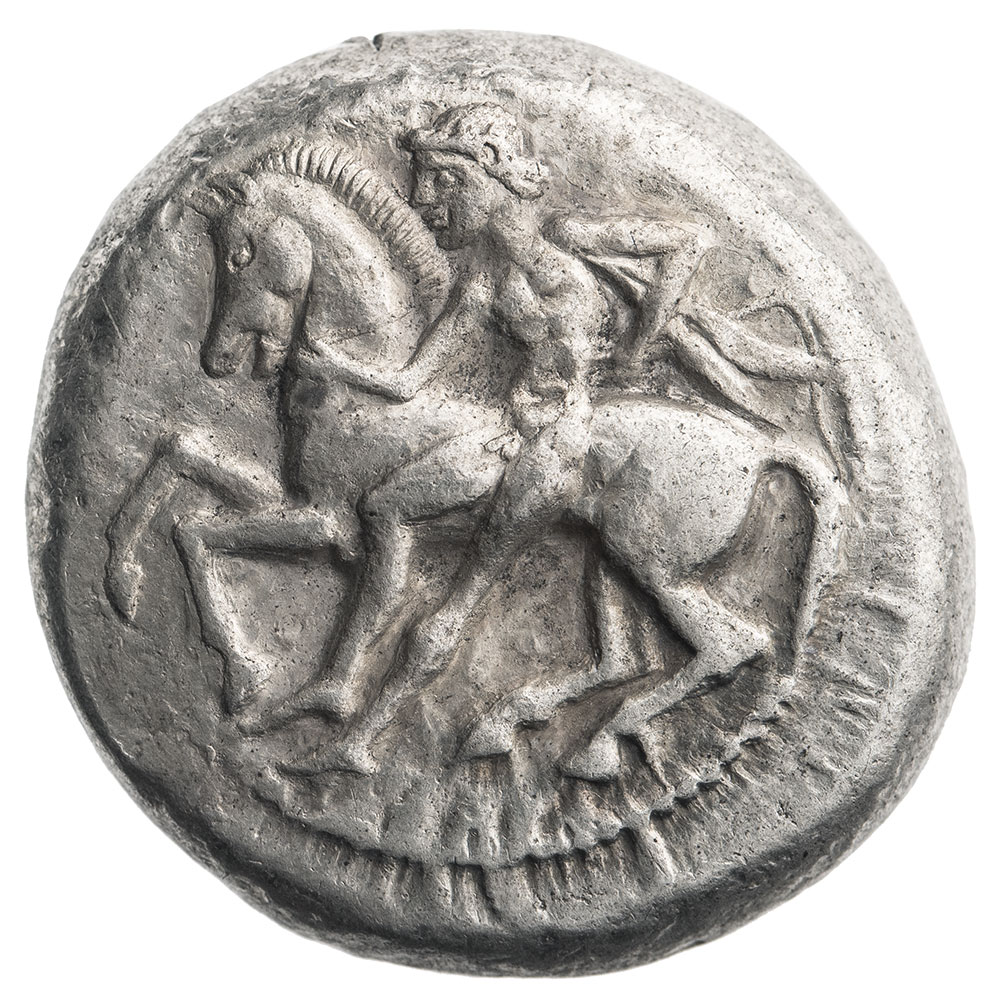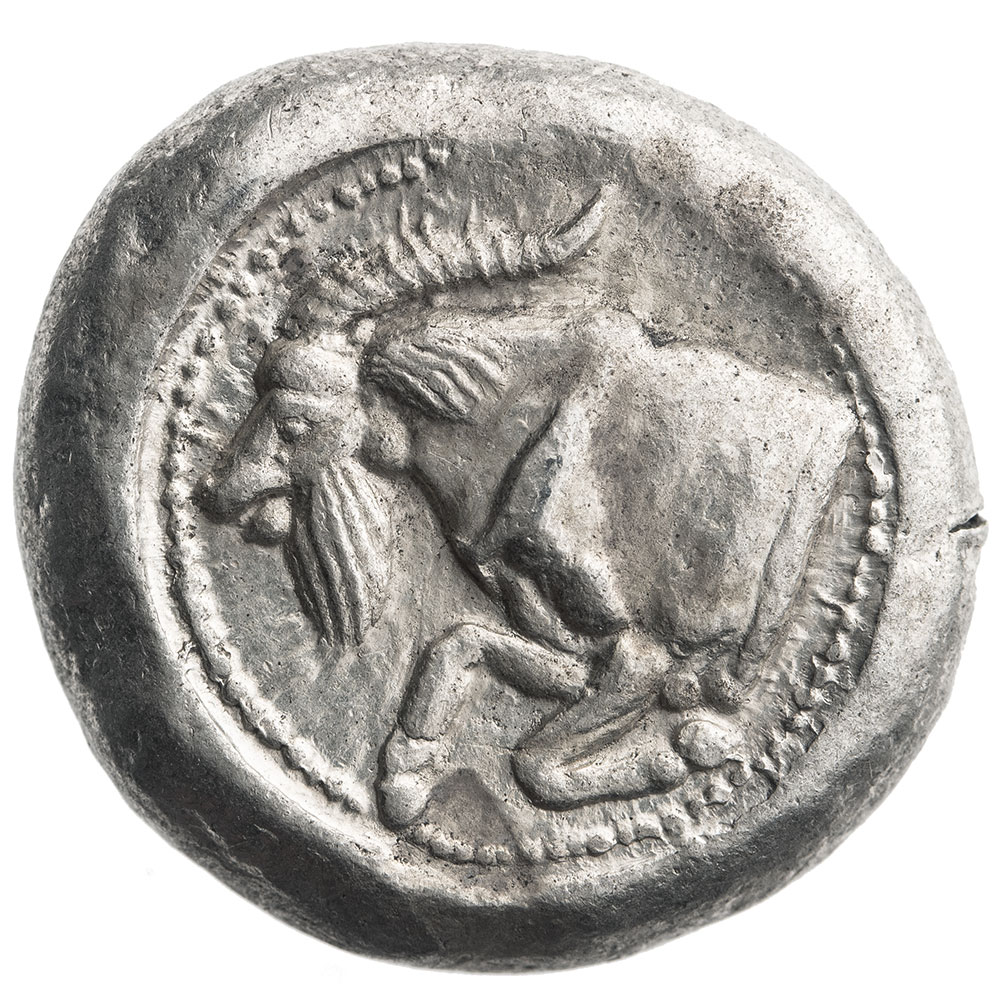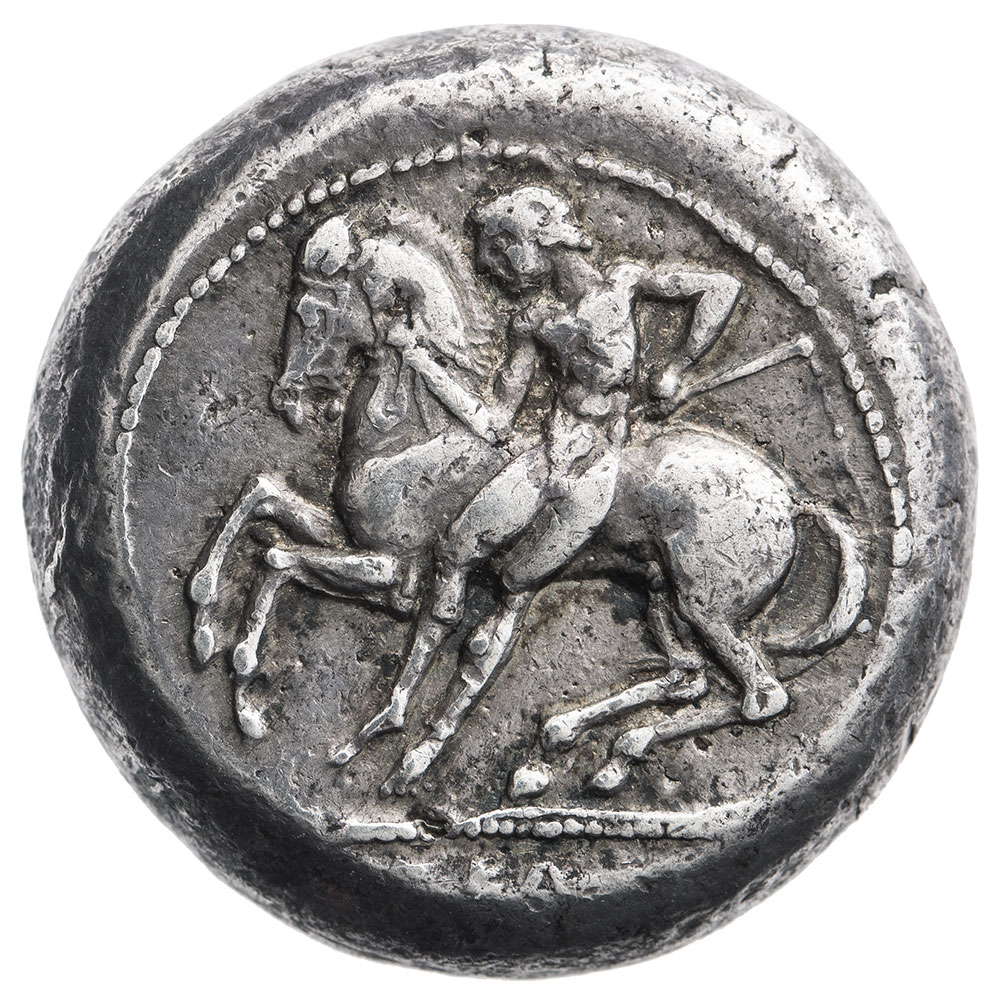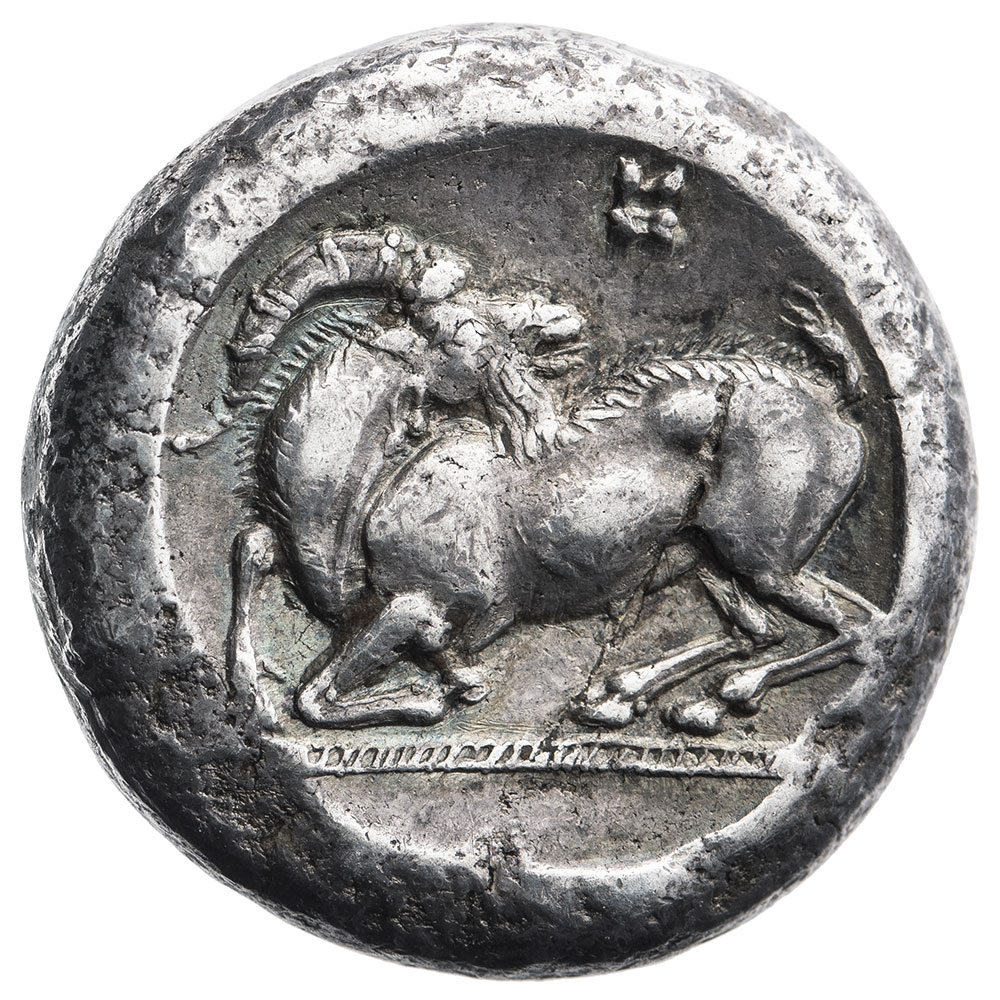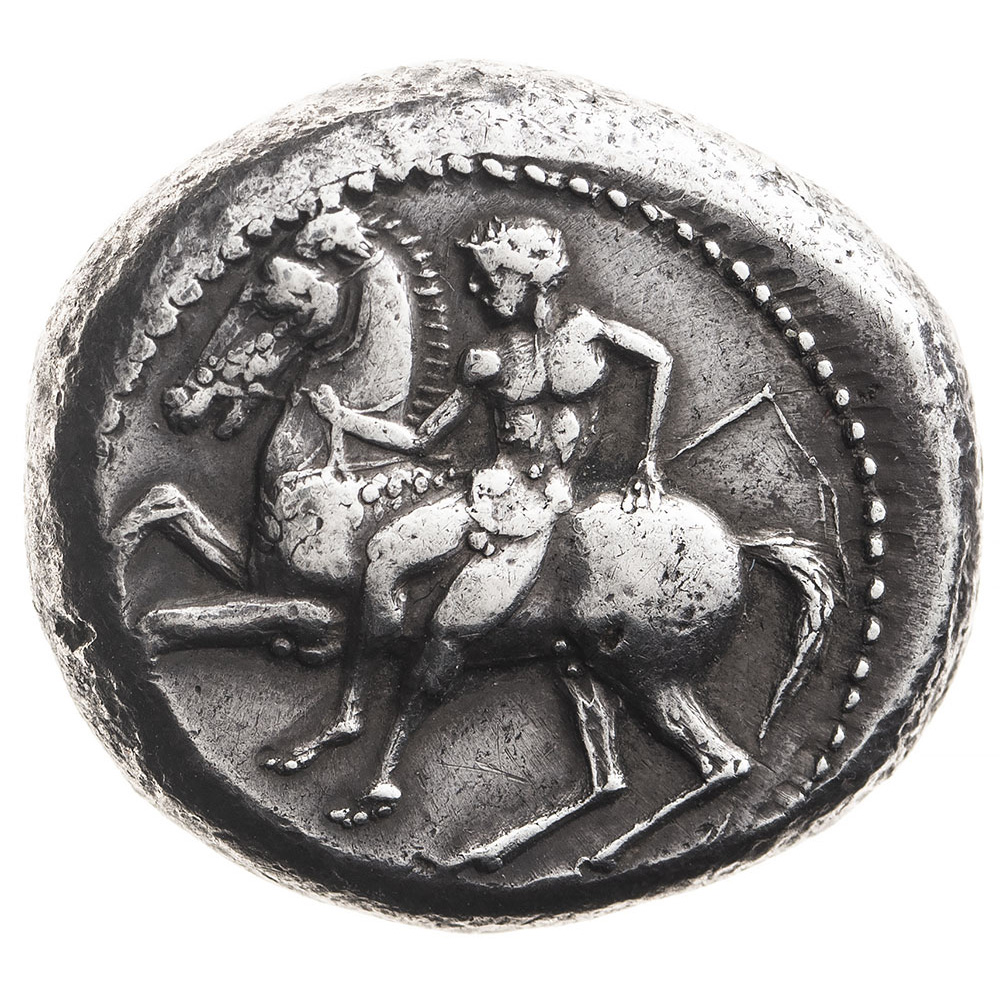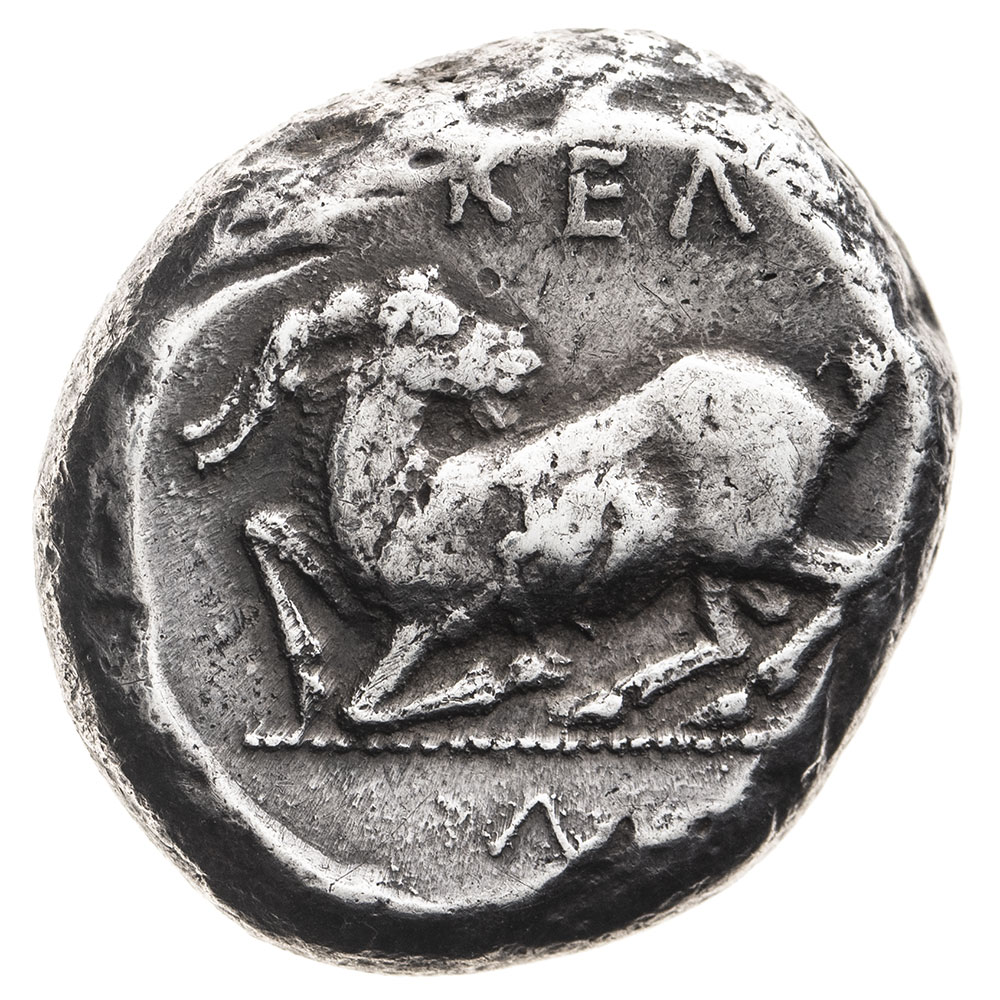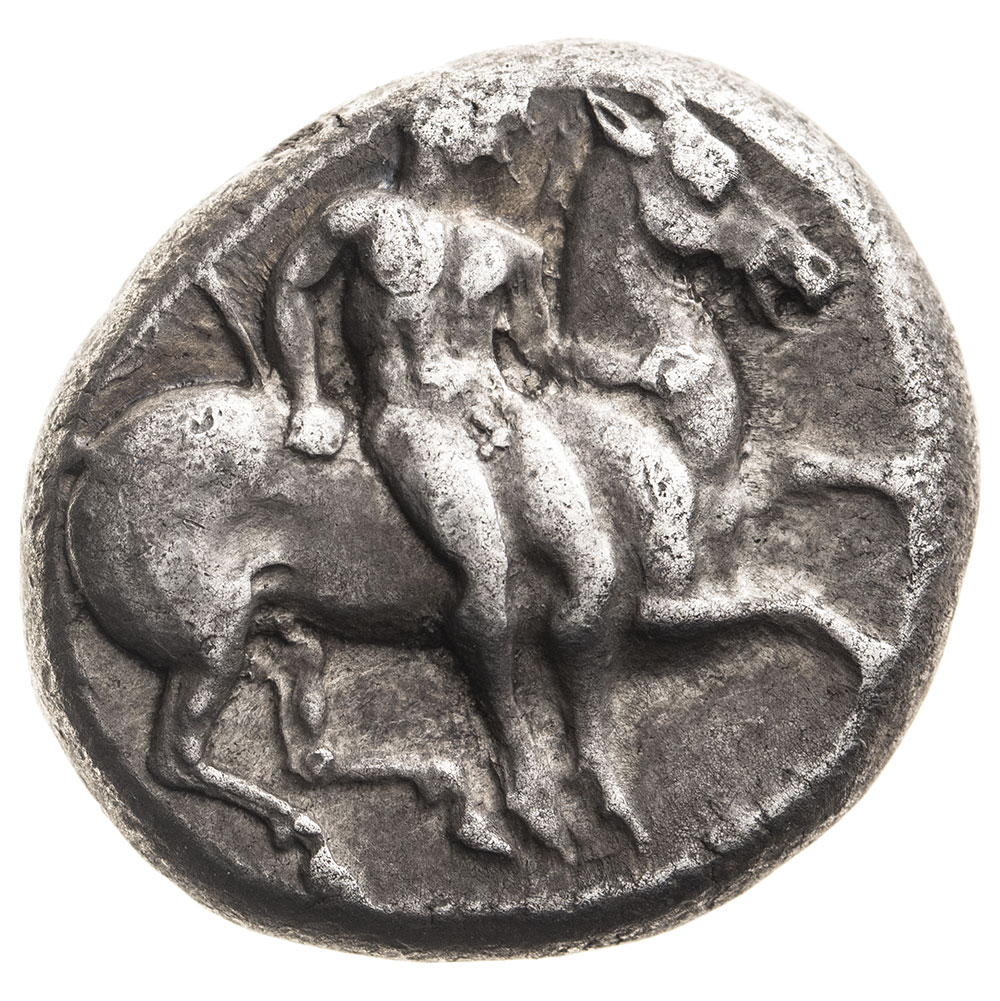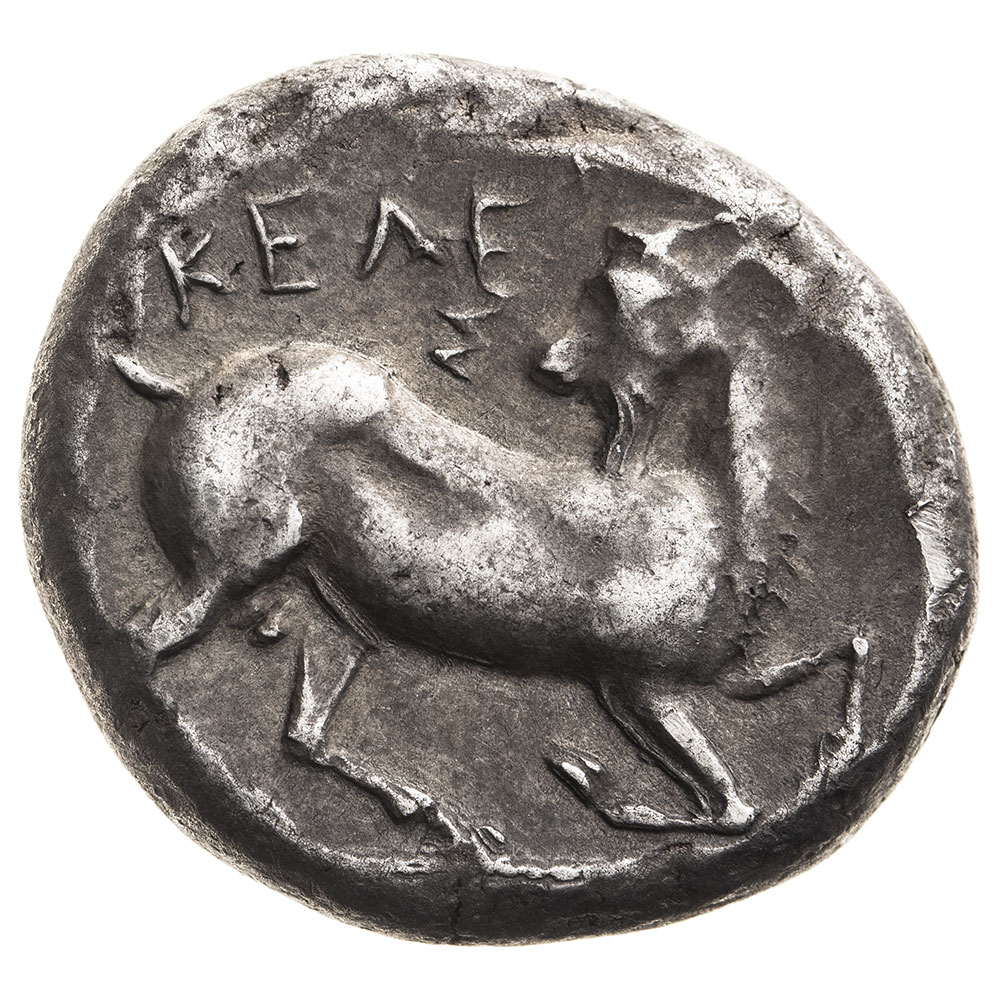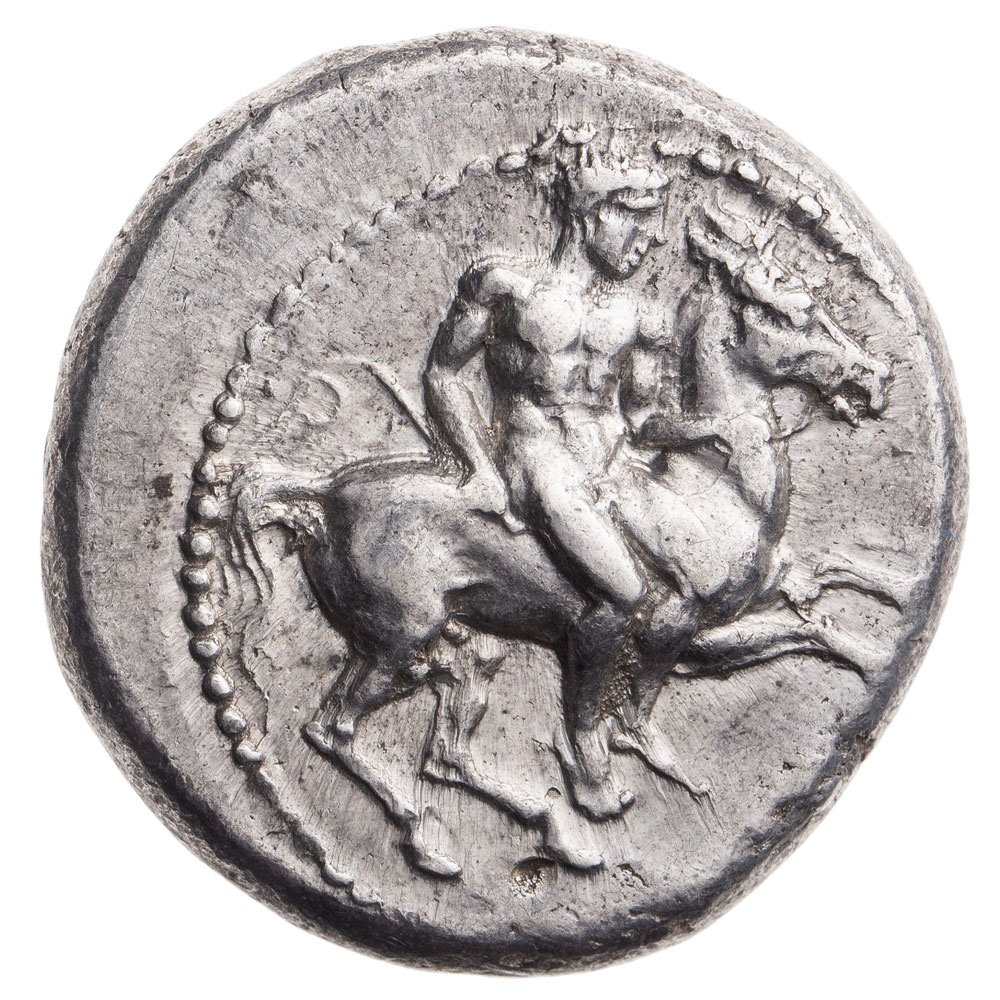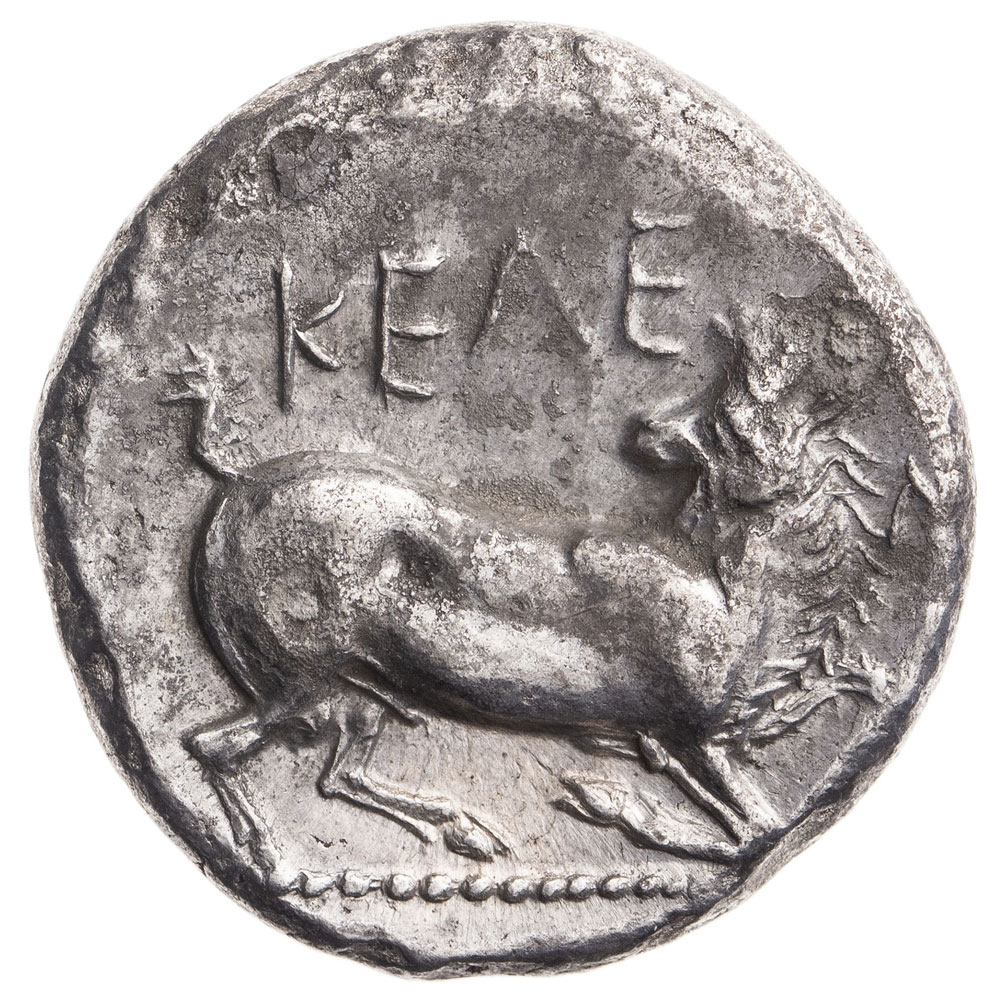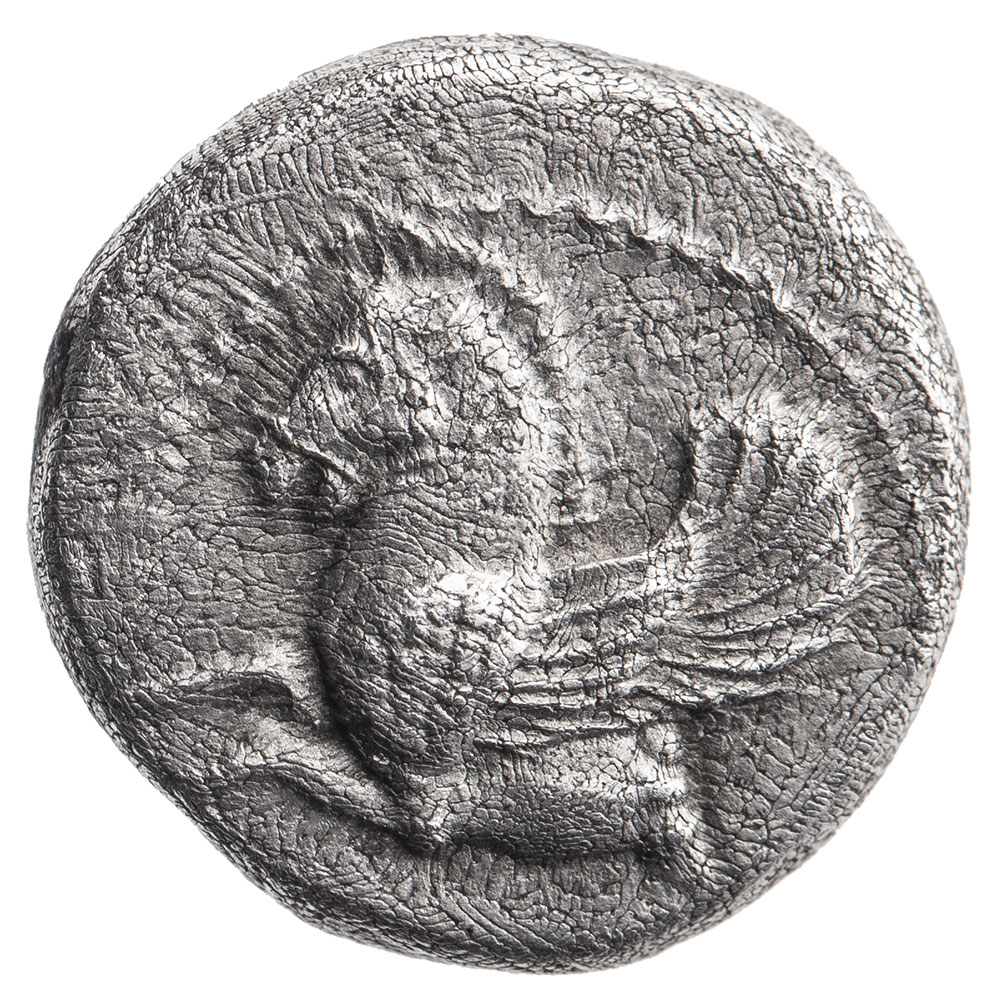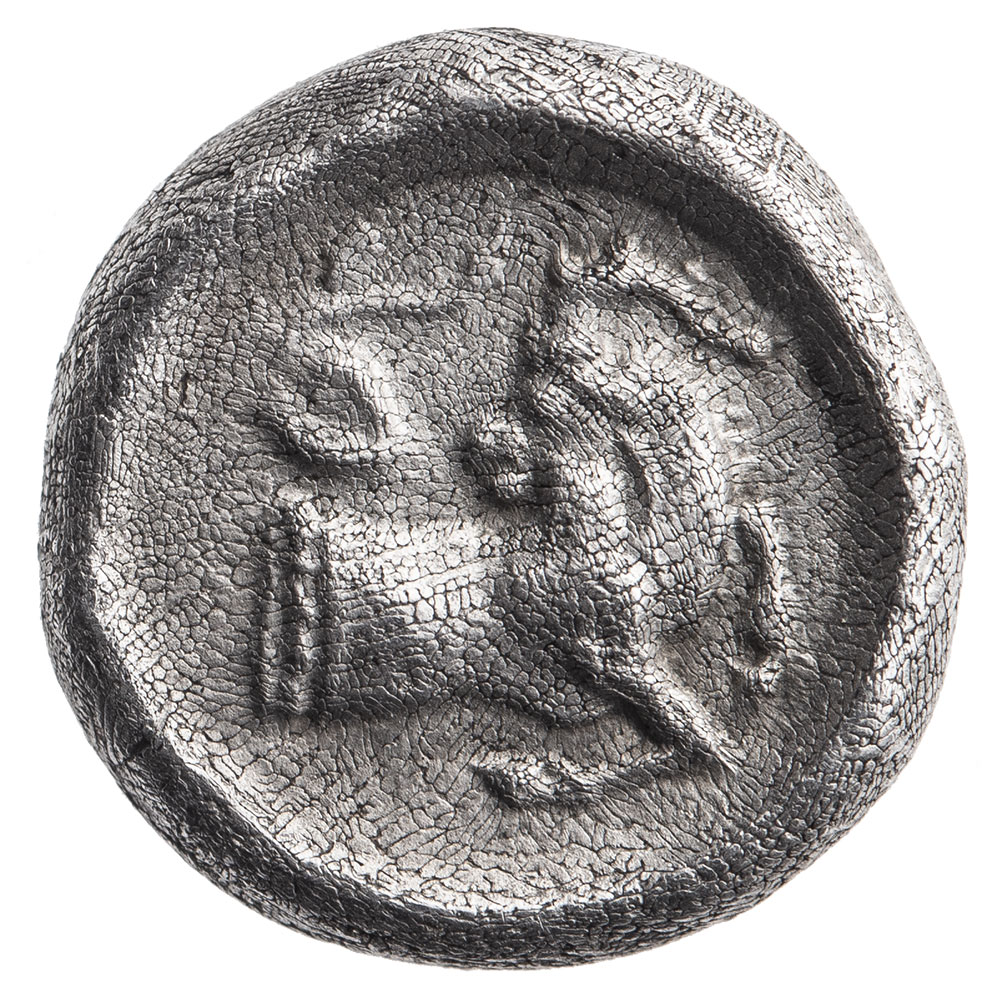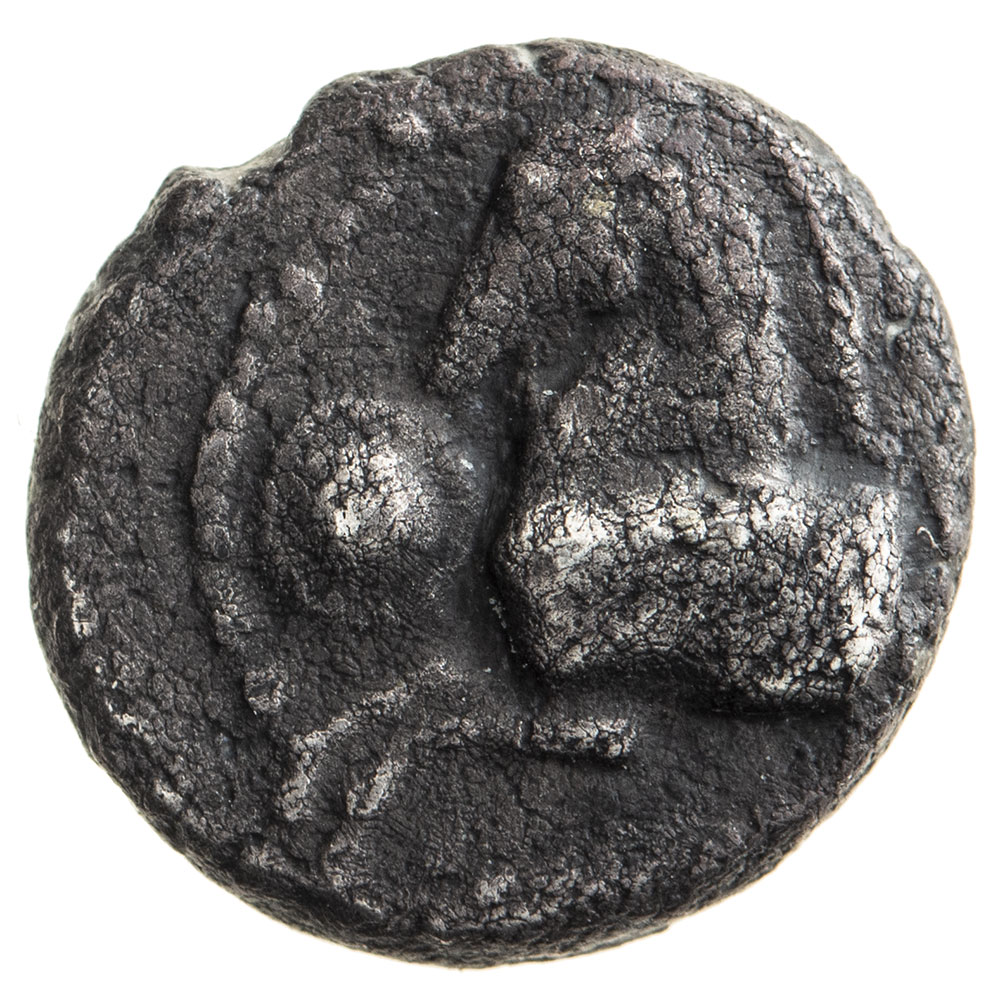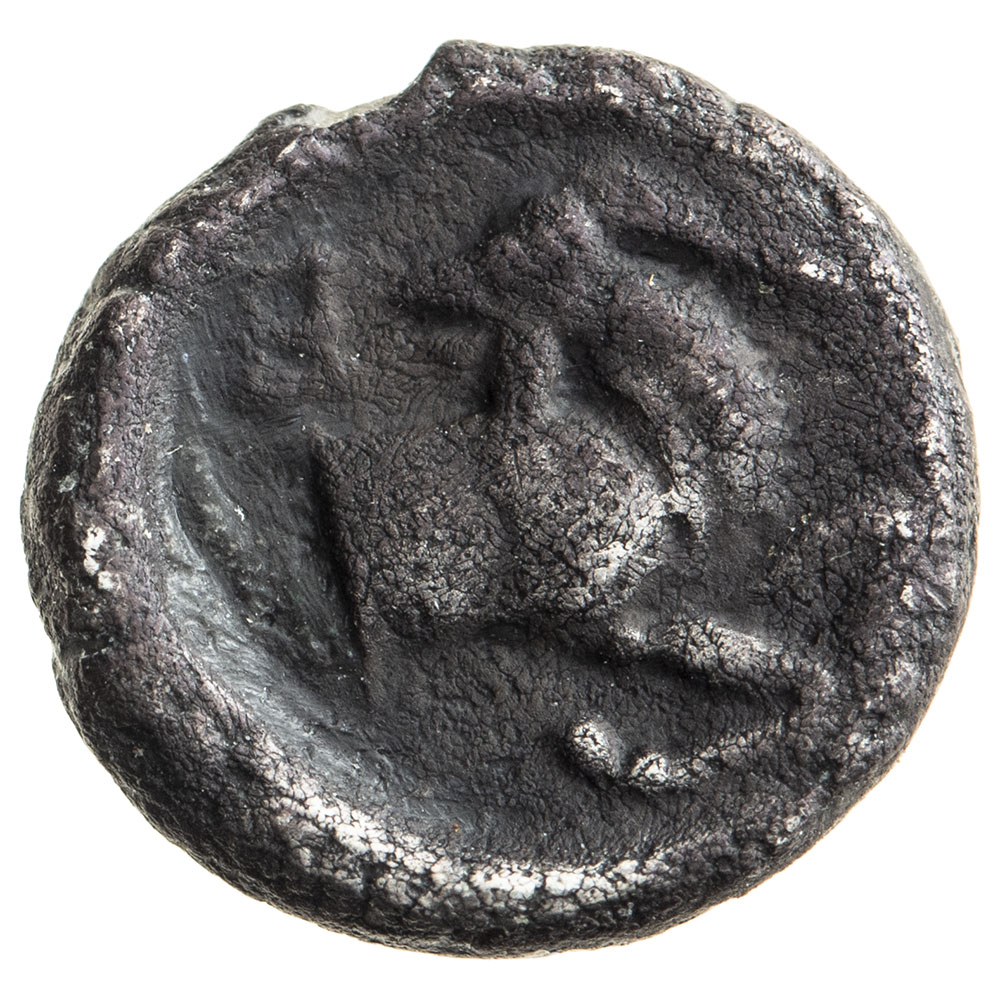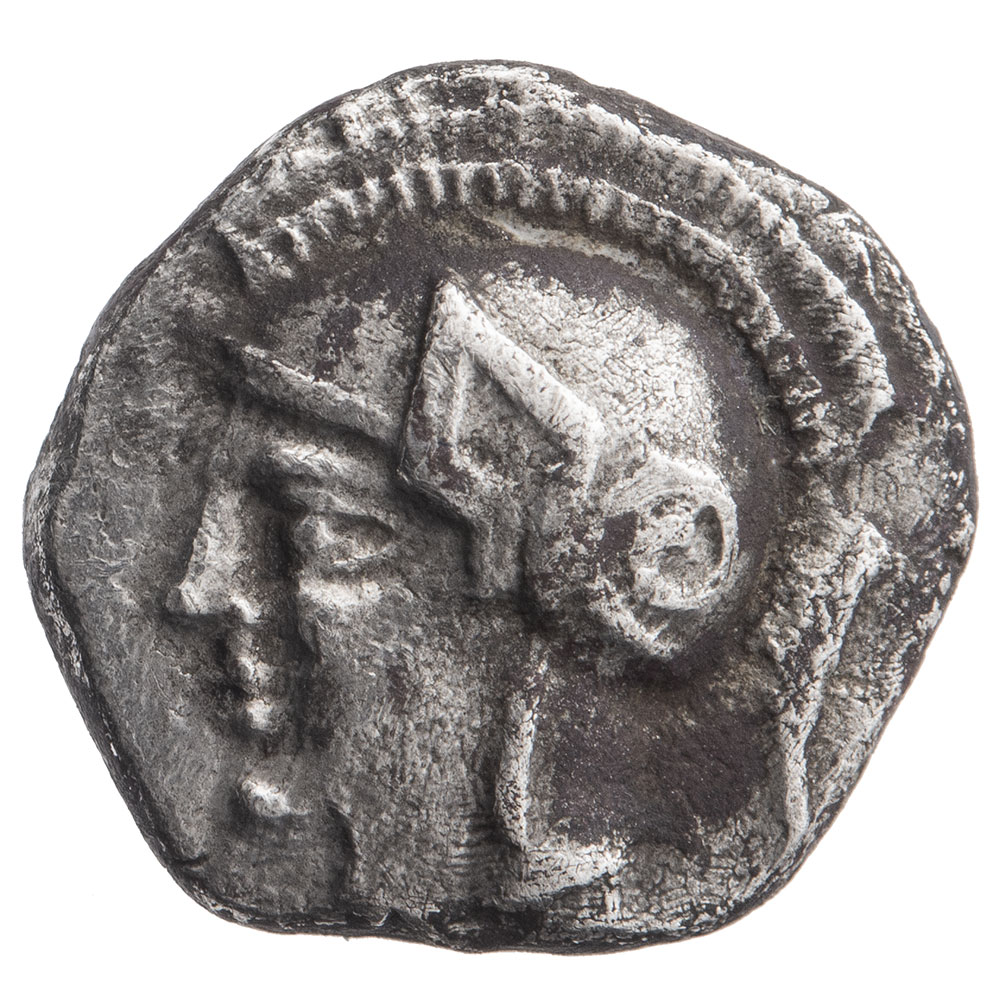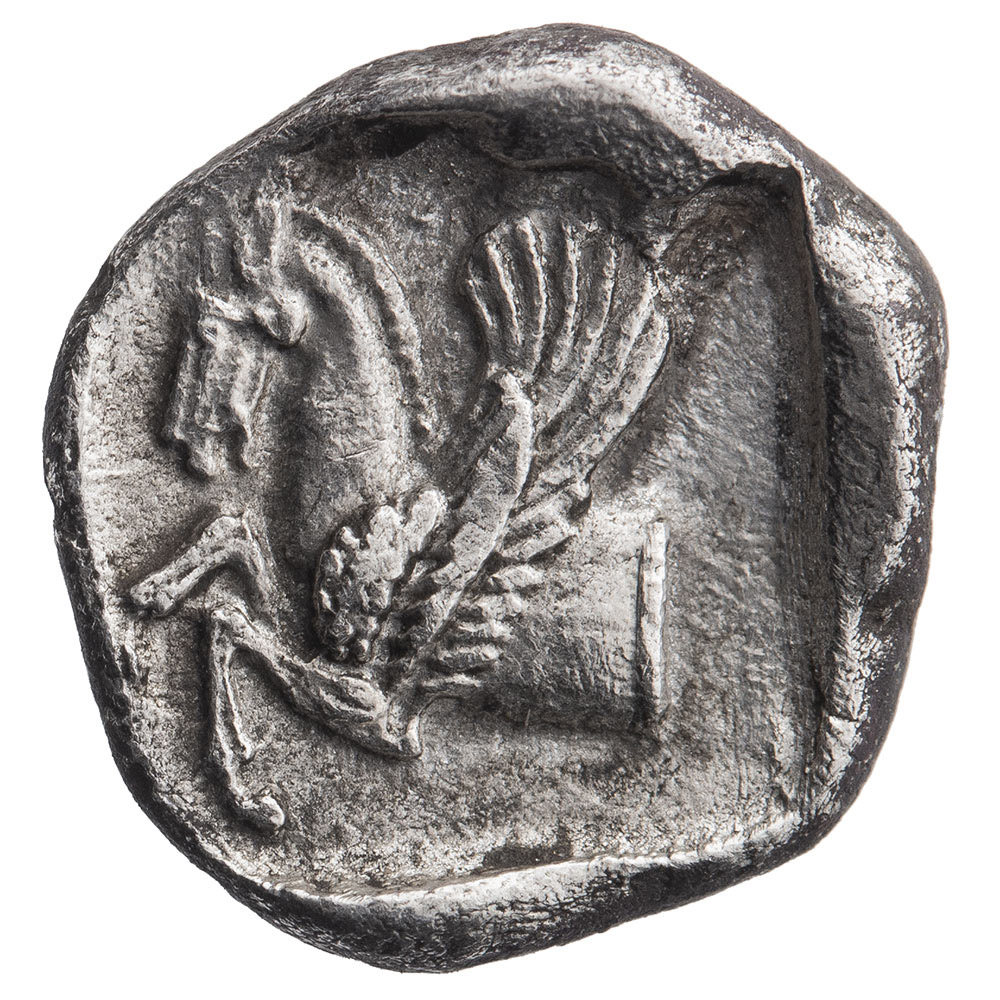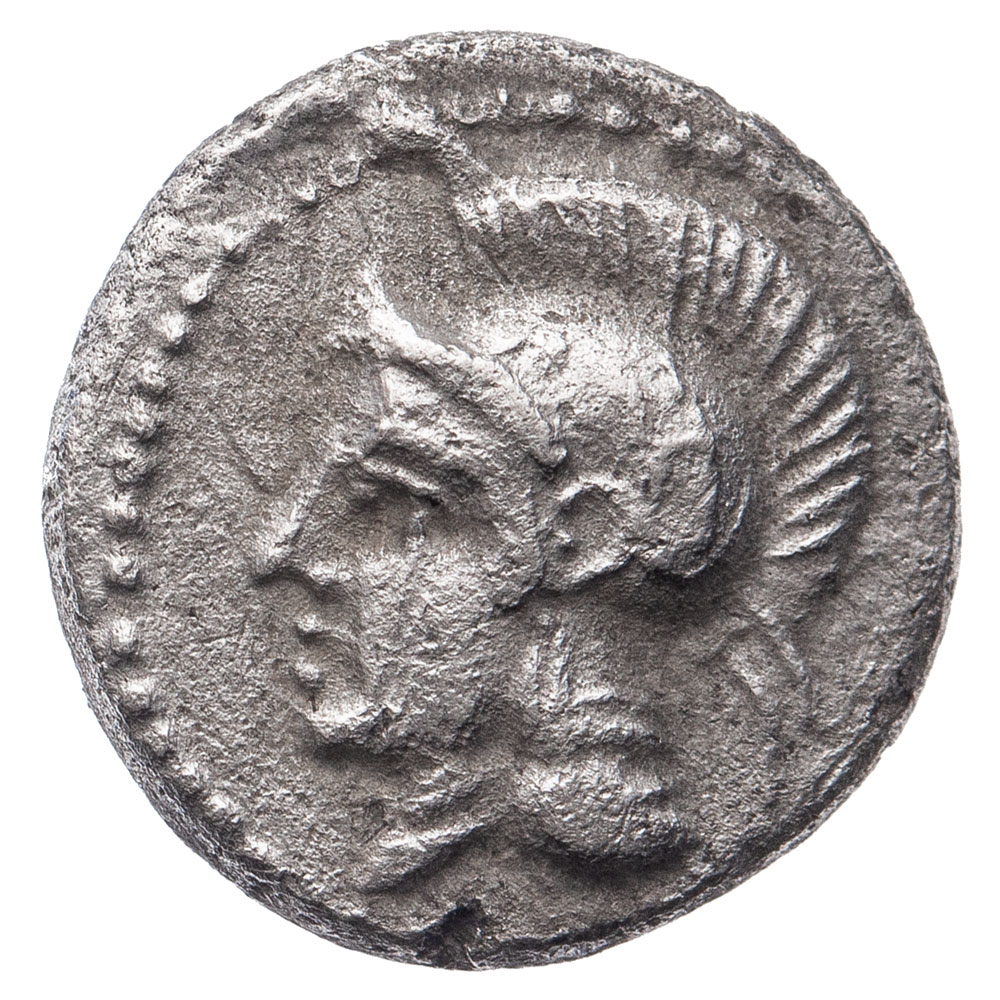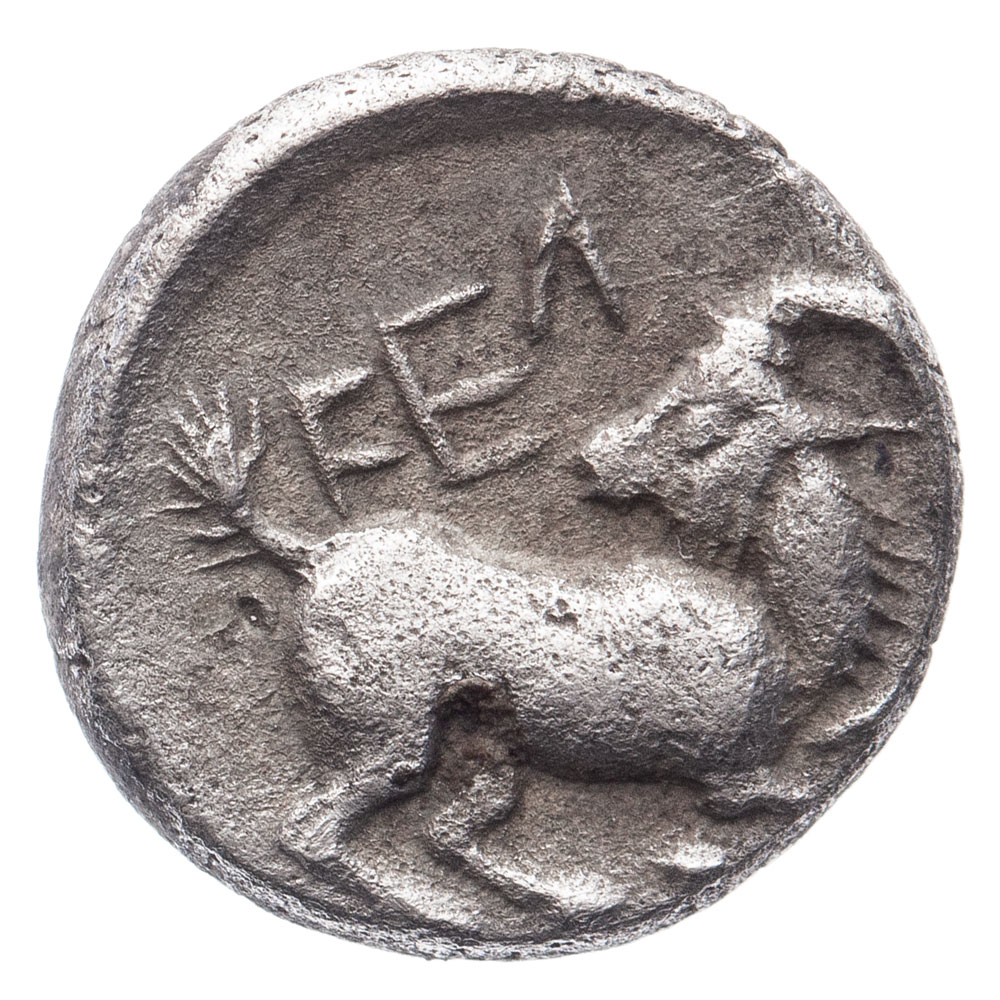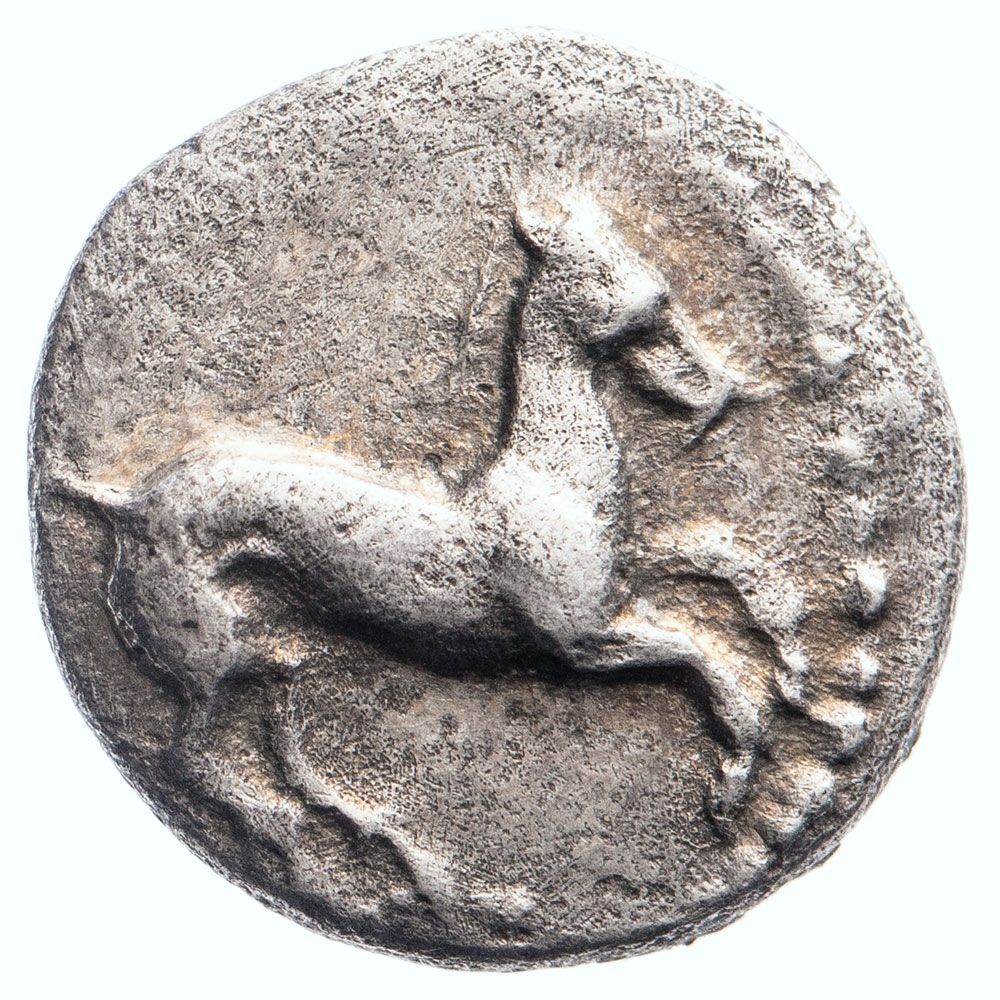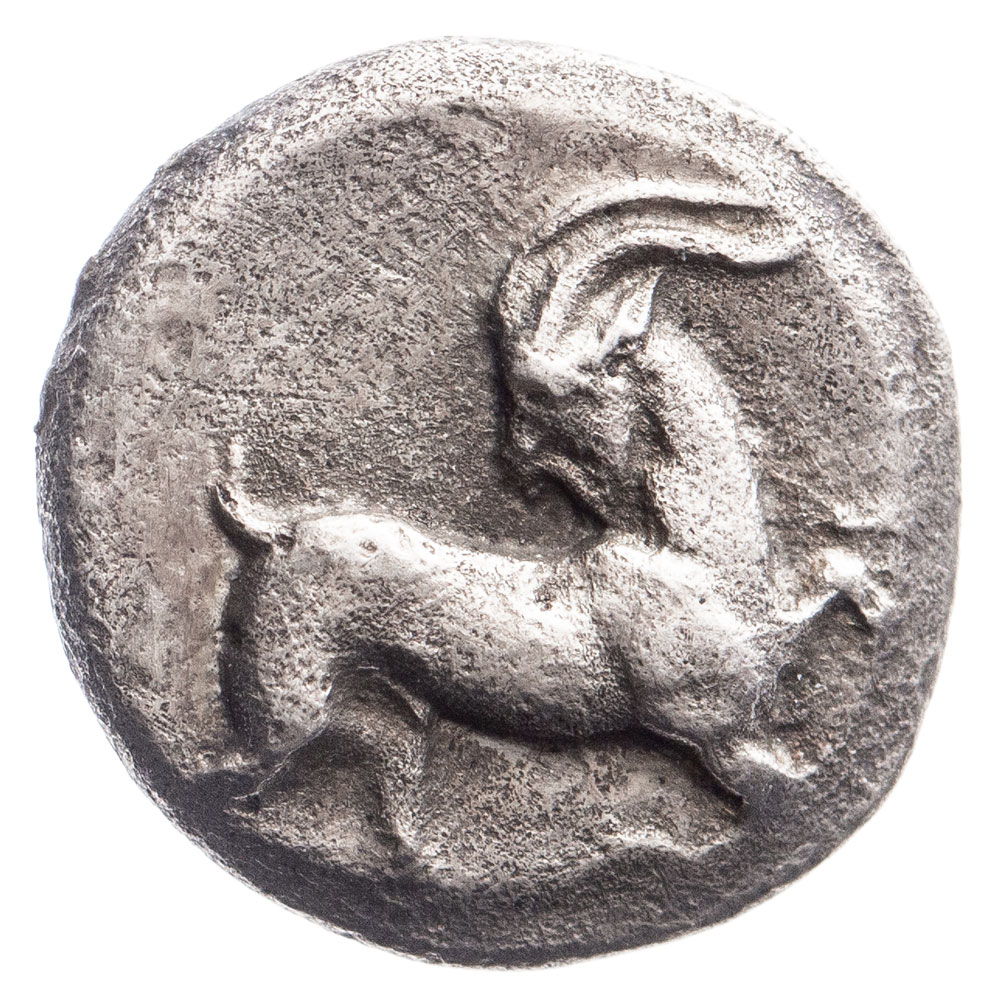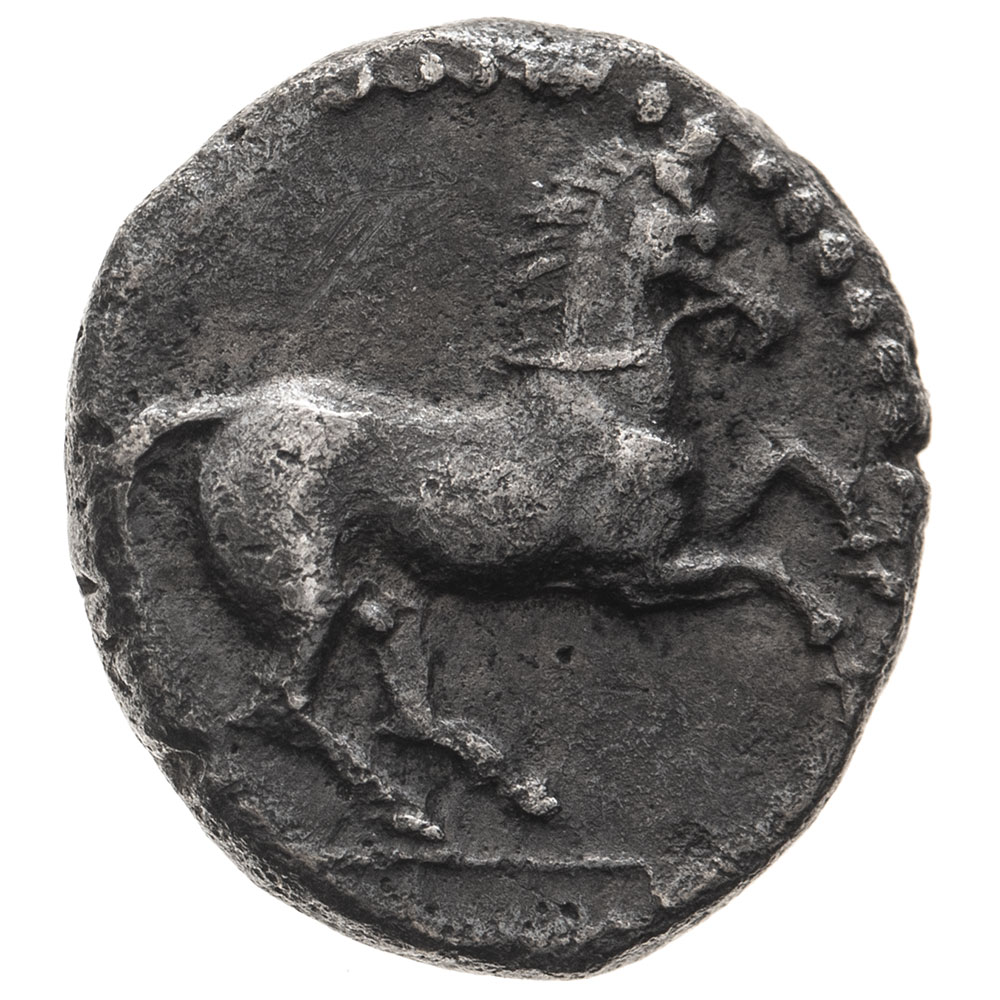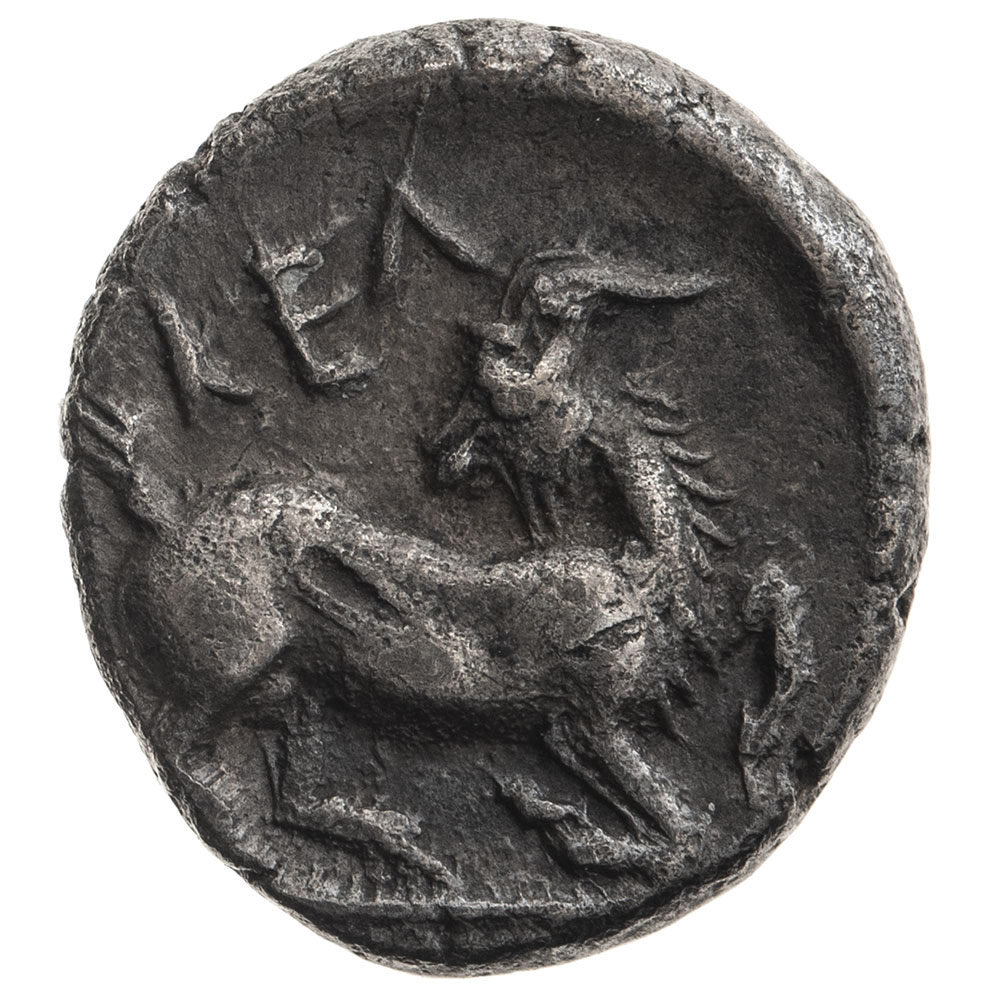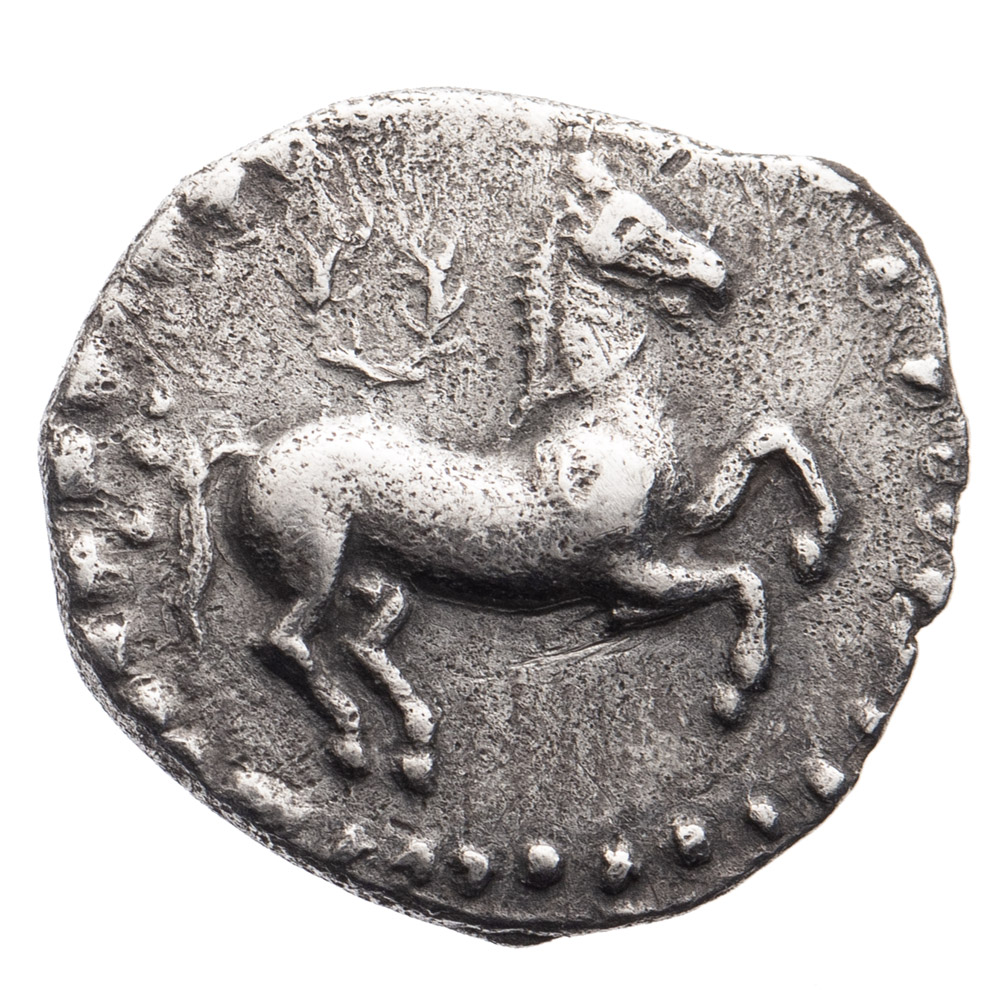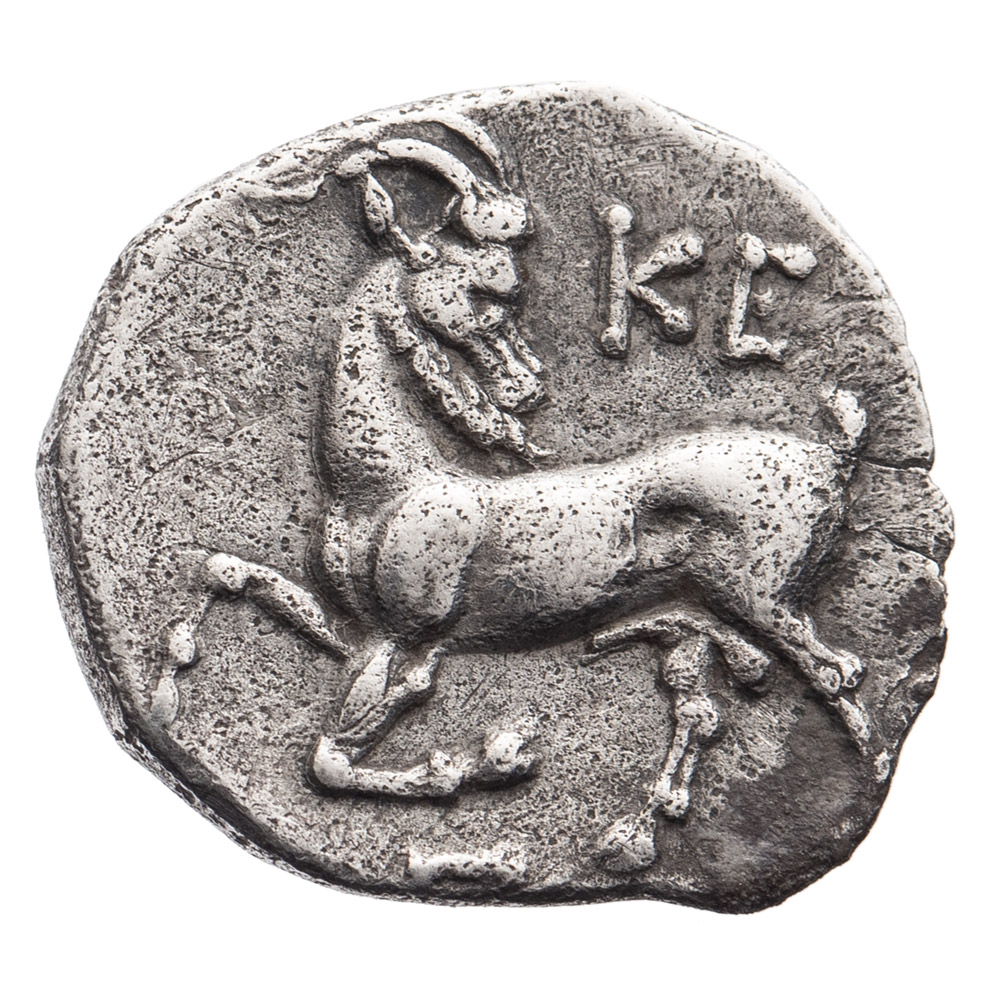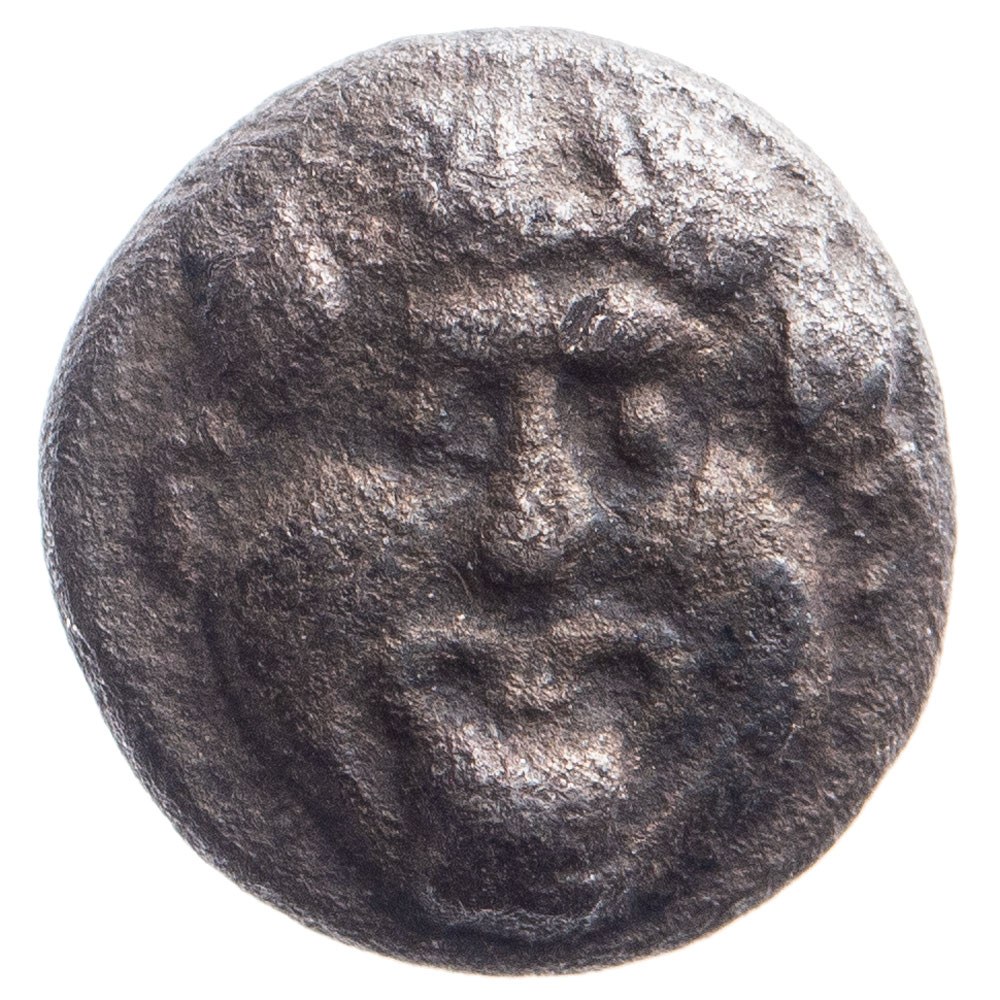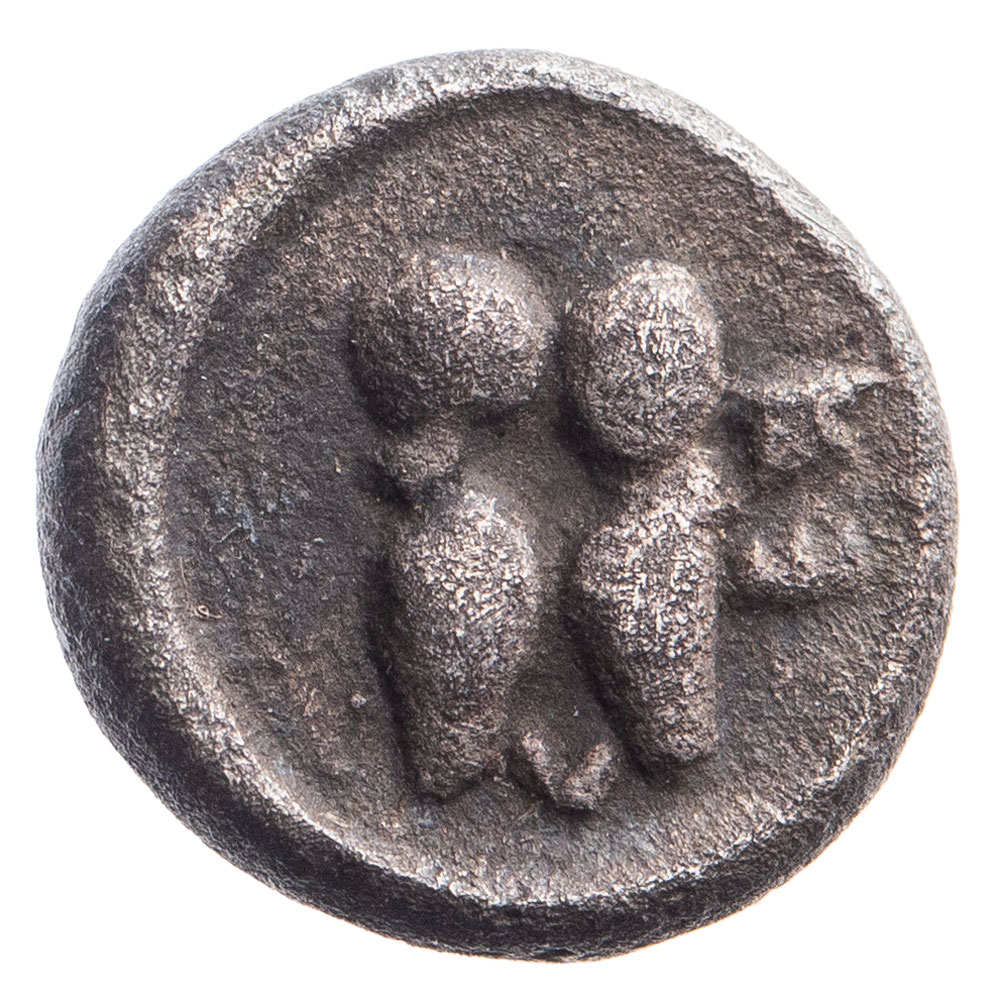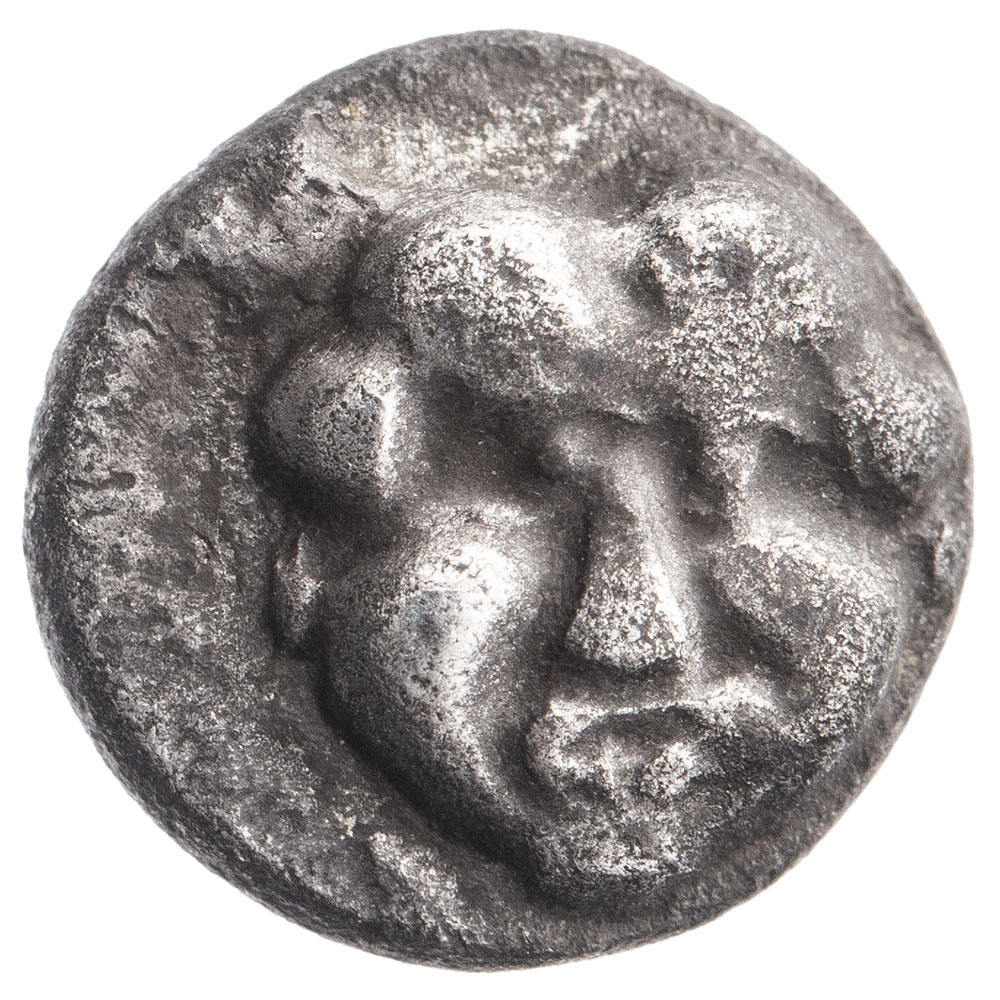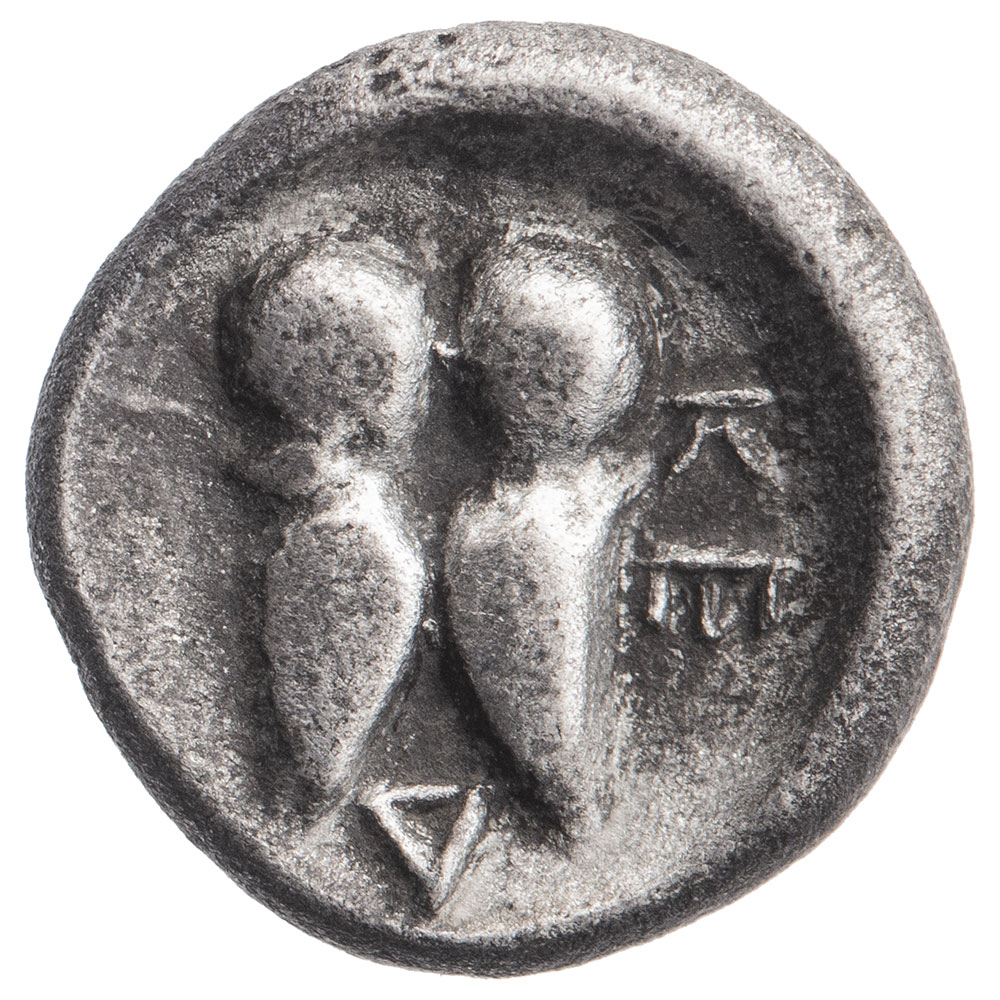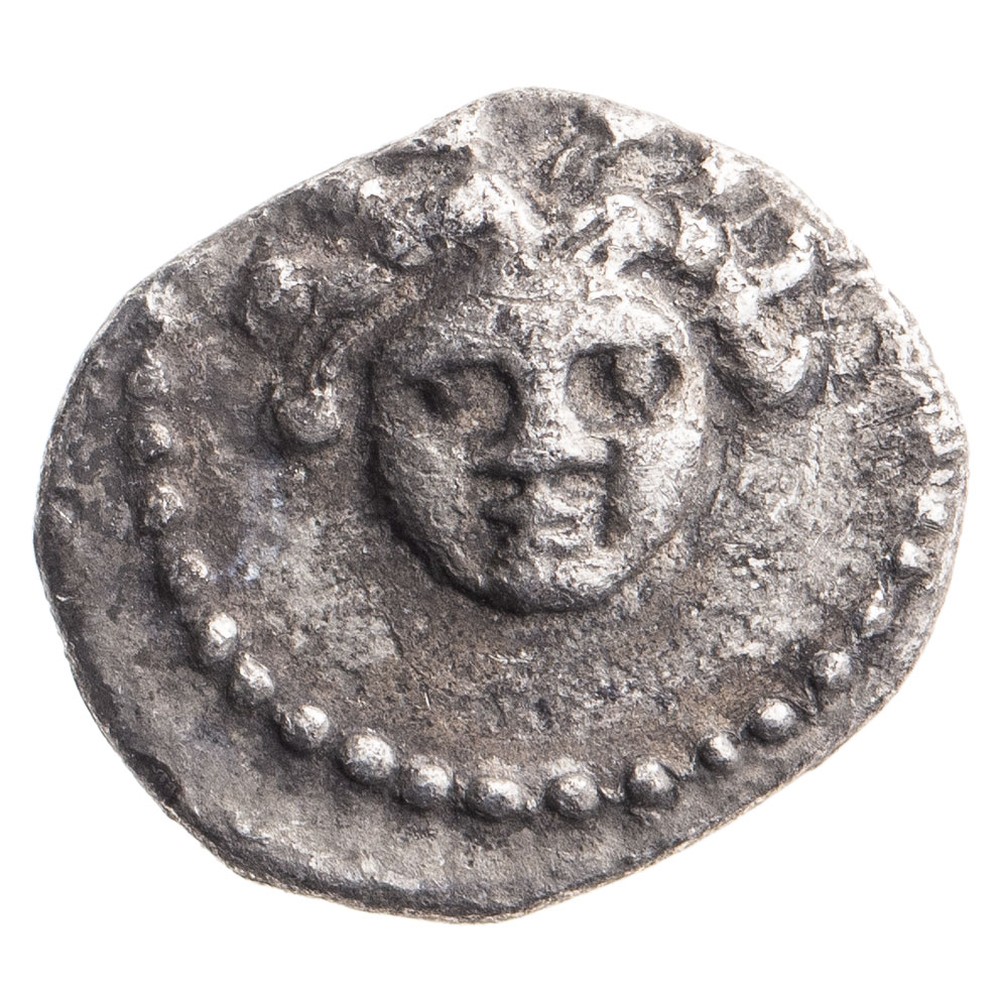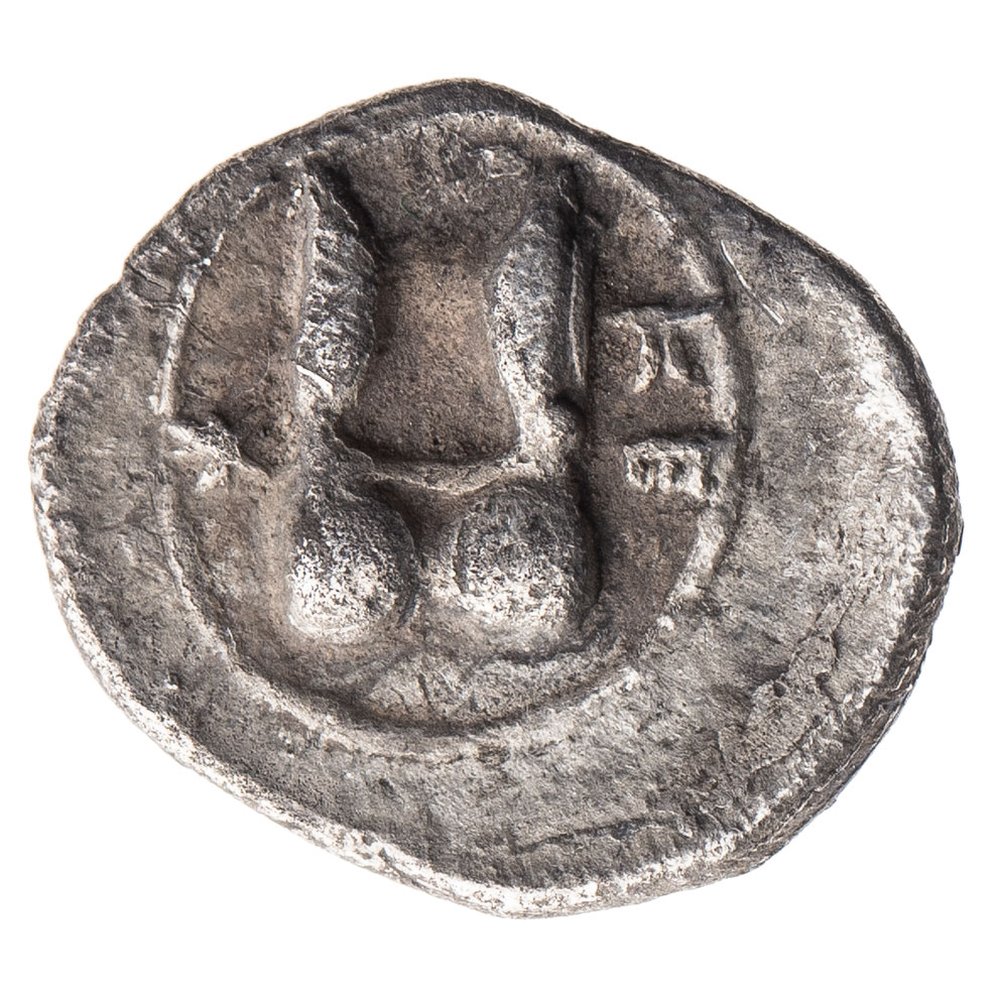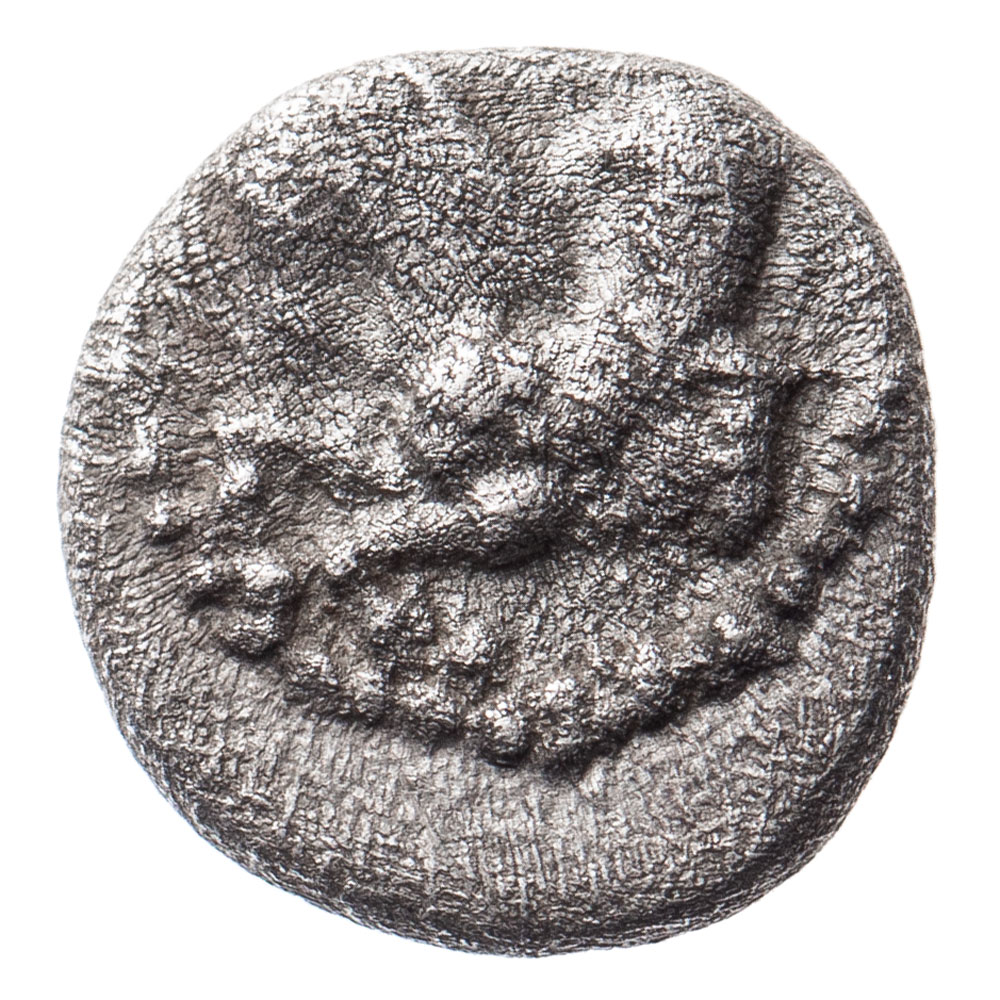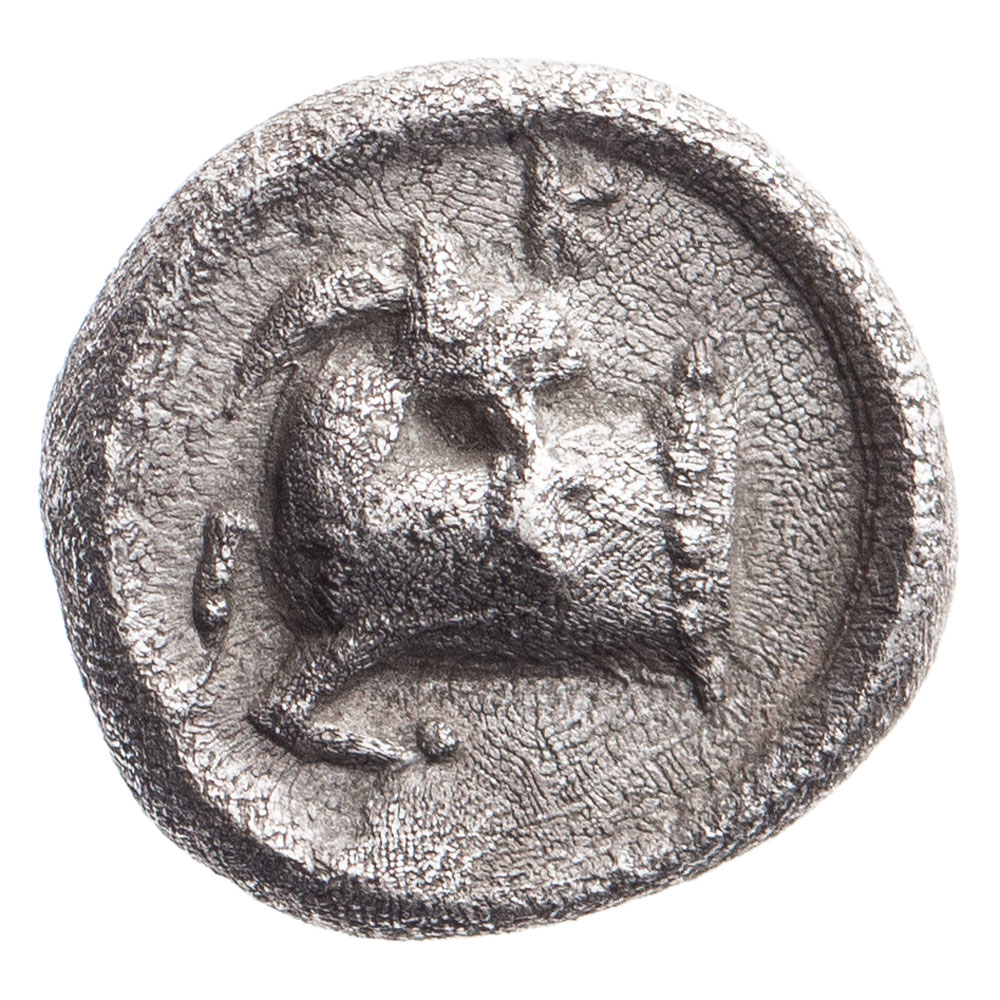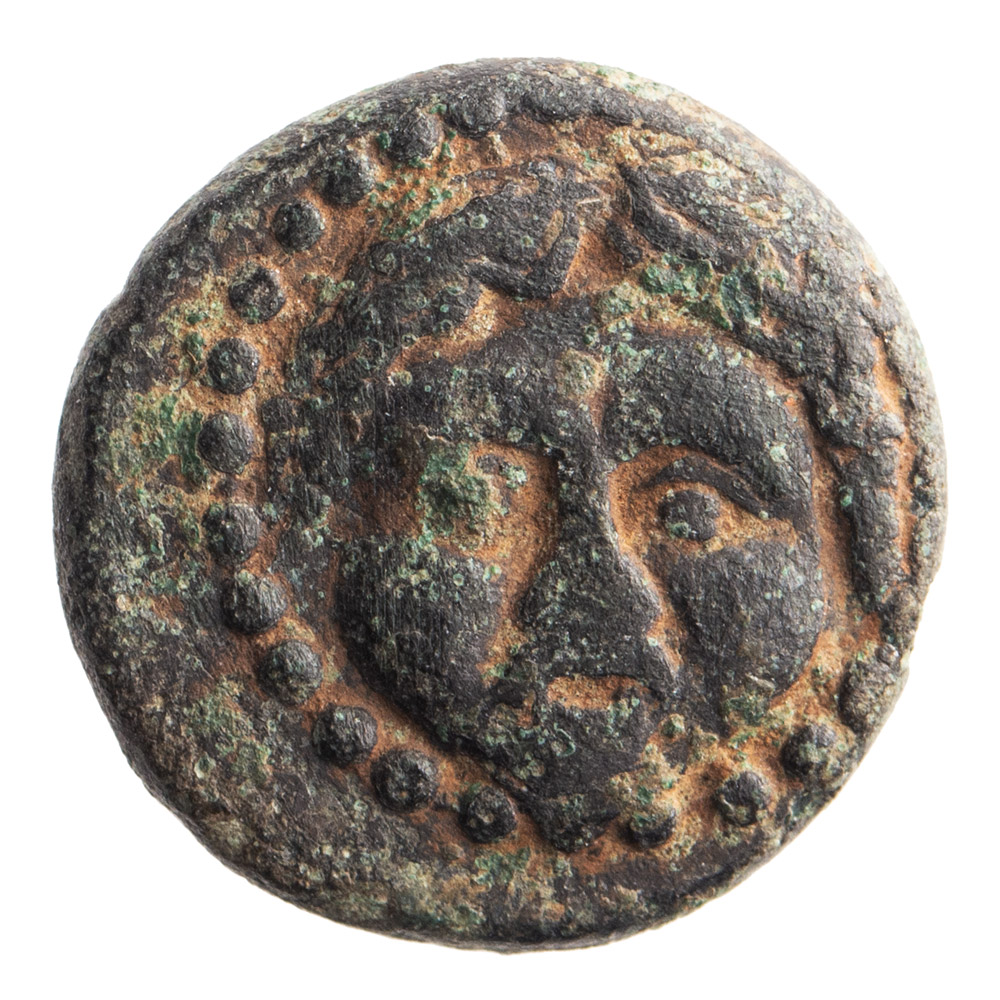AR Staters AR Third staters AR Obols AR Hemiobols Bronze coins
AR Staters
| Denomination: | AR Stater |
| Period: | c. 450 BC |
| Weight: | 11.01 g |
| Diameter: | 18–20 mm |
| Obverse: | Youthful rider, nude except for flying chlamys, holding reins in right hand and whip in left, dismounting from horse rearing to left; dotted border. |
| Reverse: | Forepart of goat kneeling to left; dotted border; all within circular incuse. |
| Die axis: | -83° |
| Catalogue: | Kelenderis, 1.3a |
| Provenance: | Gerhard Hirsch Nachfolger, Auction 368 (23 September 2021), Lot 3162 (acsearch.info URL) |
| Remarks: |
The engraver of the obverse die tried to express the dynamics of the scene. The chlamys flies behind the rider’s back and partially covers the rider’s whip, which points to the rear of the horse due to the position of the rider’s left hand when dismounting. The rider’s flying chlamys is similarly depicted in a scene on an amphora originating probably from Kamiros in Rhodes, c. 525 BC–500 BC (The British Museum, 1867,0506.44), but the rider on the amphora is also wearing a short chiton. Note that on the Parthenon friezes some riders wear the chlamys only (others wear the chiton only or both garments together, some also a cuirass). |
| Denomination: | AR Stater |
| Period: | c. 450 BC |
| Weight: | 10.78 g |
| Diameter: | 20–20 mm |
| Obverse: | Youthful rider, nude except for flying chlamys fastened on the chest, holding reins in right hand and whip or cutlass (makhaira) in left, dismounting from horse rearing to left; dotted border. |
| Reverse: | Forepart of goat kneeling to left; dotted border; all within deep circular incuse. |
| Die axis: | 90° |
| Catalogue: | Kelenderis, 1.3b |
| Provenance: | Gerhard Hirsch Nachfolger, Auction 386 (7 February 2024), Lot 1149 (acsearch.info URL). Ex Since the 1990s in a German private collection. |
| Remarks: |
This coin differs from the coin KEL-AR-05 above in the way the rider’s chlamys is depicted. It shows the clasp of the chlamys on the rider’s chest near his right shoulder, the chlamys is draped over his shoulders and flutters backwards away from the viewer so it does not overlap the object in his left hand. This object does not have to be a whip. Due to the absence of a strap and due to its width and slightly curved shape, it may be a cutlass (makhaira), similar to the one on the coins of Type 1 from a Pseudo-Kelenderis mint. However, this coin shows a similarity to the coin KEL-AR-05 on the lower part of the obverse. It is not clear if these are two reworked versions of the same die. It should also be noted that the right foreleg of the horse is not depicted anatomically correctly on this coin. |
| Denomination: | AR Stater |
| Period: | c. 450–405 BC |
| Weight: | 10.69 g |
| Diameter: | 18–19 mm |
| Obverse: | Youthful nude rider, holding reins in right hand and whip in left, dismounting from horse rearing to left on dotted exergual line; in exergue, KEΛ; dotted border. |
| Reverse: | Male goat kneeling to left on double exergual line with hatched markings, head turned back to right; above goat, astragalos; all within circular incuse. |
| Die axis: | 90° |
| Catalogue: | Kelenderis, 2.2a |
| Provenance: | Dr. Busso Peus Nachfolger, Auctions 433 (1 November 2022), Lot 1329 (acsearch.info URL). Ex Nomos AG, Auction 14 (17 May 2017), Lot 155 (acsearch.info URL). Ex Hess-Leu, Auction 28 (5 May 1965), Lot 258 (Plate XI, no. 257). Ex The Stoecklin Collection (1958). |
| Denomination: | AR Stater |
| Period: | c. 450–405 BC |
| Weight: | 10.82 g | |
| Diameter: | 17–19 mm | |
| Obverse: | Youthful nude rider, holding reins in right hand and whip in left, dismounting from horse rearing to left on solid exergual line; the horse decorated with ornamental collar; the whip ended with two thongs; dotted border. | |
| Reverse: | Male goat kneeling to left on dotted exergual line, head turned back to right; above goat, KEΛ; in exergue, Λ. | |
| Die axis: | -130° | |
| Catalogue: | Kelenderis, 2.6c | |
| Provenance: | Classical Numismatic Group, Electronic Auction 491 (5 May 2021), Lot 118 (acsearch.info URL). Ex Dr. Busso Peus Nachfolger, Auctions 343 (26 April 1995), Lot 172. |
|
| Remarks: | (1) |
The decorative collar around the horse’s neck may have been intended to keep off the Evil Eye (Anderson, p. 85). A similar ornamental collar is shown on Kastor’s horse on Attic black-figure amphora from c. 540–530 BC signed by Exekias (Gregorian Etruscan Museum, 16757; illustrated in Anderson, pl. 20). Another type of such collar probably serving the same purpose is mentioned in epigram 6.246 of the Greek Anthology, the author of which is either Philodemos of Gadara (1st century BC) or Marcus Argentarius (1st century AD). Two translations of this epigram: Charmus from his Isthmian victory dedicates in thy porch, Poseidon, his spurs that urge the horse on its way, the muzzle that fits on its nose, its necklace of teeth, and his willow wand, also the comb that drags the horse’s hair, the whip for its flanks, rough mother of smacking blows. Accept these gifts, god of the steel-blue locks, and crown the son of Lycinus in the great Olympian contest too. Transl. by William Roger Paton (The Greek Anthology, Vol. I, 1916) Course-chasing spurs, nostril-hugging muzzle, tooth-bearing breastpiece, and willow wand(?) —these Charmos has dedicated in your porch, Poseidon, because of his Isthmian victory— and the horses‘ curry comb and whip for their rumps, bold mother of whirring sound. So then, O dark-haired one, receive these, and crown the son of Lukinos also for a great Olympian contest. Transl. by Stuart G. P. Small (Sider 1997, p. 191 ff.) |
| (2) |
Kraay 1962, pp. 2-6, divides the Kelenderis staters contained in the so called Kelenderis hoard (probably found in 1957 or shortly before) into 4 series:
The numbering of these series corresponds to their chronological order (ibid, p. 6), with the burial of the hoard falling roughly in the year 401 BC (ibid, p. 15). This coin belongs to Series III (dies O11/R7B), but its obverse die is also linked to Series I and II by some other reverse dies (ibid, dies R2B and R7B). Moreover, this obverse was also used with reverse dies with a goat oriented to the right (ibid, dies R10, R11 and R12), a characteristic of Series IV. The artistic rendering of the horseman also represents a transition from earlier editions of the 5th century BC to more later classical design. This coin therefore represents a transition from the early style of the second half of the 5th century to the classical style that came into use from the late 5th century to the last quarter of the 4th century. |
|
| Denomination: | AR Stater |
| Period: | c. 405–375 BC (?) |
| Weight: | 10.30 g |
| Diameter: | 18–20 mm |
| Obverse: | Youthful nude rider, holding reins in left hand and whip in right, dismounting from horse rearing to right; dotted border (off flan). |
| Reverse: | Male goat kneeling to right on dotted exergual line, head turned back to left; above goat, KEΛE; below ethnic, Σ; in exergue, K (off flan). |
| Die axis: | 10° |
| Catalogue: | Kelenderis, 3.8a |
| Provenance: | Roma Numismatics Limited, E-Sale 84 (16 June 2021), Lot 919 (acsearch.info URL). Ex Roma Numismatics Limited, E-Sale 64 (28 November 2019), Lot 407 (acsearch.info URL). Ex Fortuna Fine Arts, Ltd. (New York). |
| Remark: | The abbreviated ethnic KEΛE on the reverse together with the Σ mark can be read as keles (κέλης), i.e. horse race. The inscription can thus be understood as an allusion to the theme depicted on the obverse (see also Coin Catalogue / Notes / The κέλης and the κελάδες). |
| Denomination: | AR Stater |
| Period: | c. 405–375 BC (?) |
| Weight: | 10.49 g |
| Diameter: | 20–21 mm |
| Obverse: | Youthful nude rider, holding reins in left hand and whip in right (whip thong forms a loop), dismounting from horse rearing to right; dotted border. |
| Reverse: | Male goat kneeling to right on dotted exergual line, head turned back to left; above goat, KEΛE-N; all within circular incuse. |
| Die axis: | -170° |
| Catalogue: | Kelenderis, 3.9b |
| Provenance: | Heritage Auctions, Inc., Auction 3102 (2 November 2022), Lot 32159 (acsearch.info URL) |
AR Third staters
| Denomination: | AR Third stater |
| Period: | 2nd half of the 5th century BC – 4th century BC |
| Weight: | 3.45 g |
| Diameter: | 13–14 mm |
| Obverse: | Youthful nude rider, holding reins in right hand and whip in left, dismounting from horse rearing to left on dotted exergual line; behind forelegs of the horse under the rider’s feet, letter Λ; dotted border. |
| Reverse: | Forepart of goat kneeling to left on solid or dotted exergual line, head turned back to right; above goat, [KEΛ]EN; all within circular incuse. |
| Die axis: | -110° |
| Catalogue: | Kelenderis, 4.7 |
| Provenance: | ZUZIM Inc. (acquired via VCoins), Fixed Price List (12 September 2024). Ex European Ambassador Collection formed in 1950s ’ 1960s. |
| Denomination: | AR Third stater |
| Period: | 2nd half of the 5th century BC – 4th century BC |
| Weight: | 3.48 g |
| Diameter: | 14–15 mm |
| Obverse: | Youthful nude rider, holding reins in left hand and whip in right, dismounting from horse rearing to right on solid exergual line; dotted border. |
| Reverse: | Male goat kneeling to left on dotted exergual line, head turned back to right; above goat, KEΛEN; all in circular incuse. |
| Die axis: | 45° |
| Catalogue: | Kelenderis, 4.9a |
| Provenance: | Nomos AG, Auction 32 (8 June 2024), Lot 87 (acsearch.info URL). Ex The collection of Major Anthony F. Milavic, USMC (Ret.). Ex David Vagi (January 2002). Ex Gorny & Mosch Giessener Münzhandlung, Auction 107 (2 April 2001), Lot 236 (acsearch.info URL). |
AR Obols
| Denomination: | AR Obol |
| Period: | 2nd half of the 5th century BC – 4th century BC |
| Weight: | 0.81 g |
| Diameter: | 9–9 mm |
| Obverse: | Forepart of bridled Pegasus rearing to left; dotted border. |
| Reverse: | Forepart of goat kneeling to right, head turned back; above goat, ivy leaf with stem; all within circular incuse. |
| Die axis: | 75° |
| Catalogue: | Kelenderis, 5.2e |
| Provenance: | Nomos AG, Auction 24 (22 May 2022), Lot 223 (acsearch.info URL) |
| Denomination: | AR Obol |
| Period: | 2nd half of the 5th century BC – 4th century BC |
| Weight: | 0.85 g |
| Diameter: | 8.5–9 mm |
| Obverse: | Forepart of horse rearing to left; before horse, round shield; dotted border. |
| Reverse: | Forepart of male goat kneeling to right, head turned back to left; above goat, boxed form of the letter heta; all within circular incuse. |
| Die axis: | 50° |
| Catalogue: | Kelenderis, 5.5 |
| Provenance: | Vanguard Collectables, USA (12 March 2021) |
| Denomination: | AR Obol |
| Period: | 2nd half of the 5th century BC – 4th century BC |
| Weight: | 0.74 g |
| Diameter: | 9–9 mm |
| Obverse: | Head of Athena to left, wearing crested Attic helmet. |
| Reverse: | Forepart of Pegasus rearing to left within incuse square. |
| Die axis: | 80° |
| Catalogue: | Kelenderis, 5.6 |
| Provenance: | Savoca Coins, 118th Silver Auction (21 November 2021), Lot 141 (acsearch.info URL) |
| Denomination: | AR Obol |
| Period: | 2nd half of the 5th century BC – 4th century BC |
| Weight: | 0.68 g |
| Diameter: | 8–8 mm |
| Obverse: | Head of Athena left, wearing crested Attic helmet, dotted border. |
| Reverse: | Male goat kneeling to right, head turned back to left; above goat, KEΛ; all within circular incuse. |
| Die axis: | 135° |
| Catalogue: | Kelenderis, 5.9 |
| Provenance: | N&N London Ltd, Online Auction 17 (28 May 2023), Lot 68 (acsearch.info URL) |
| Denomination: | AR Obol |
| Period: | 2nd half of the 5th century BC – 4th century BC |
| Weight: | 0.73 g |
| Diameter: | 9–10 mm |
| Obverse: | Unbridled horse prancing to right on solid exergual line; dotted border. |
| Reverse: | Male goat kneeling to right, head turned back to left. |
| Die axis: | -75° |
| Catalogue: | Kelenderis, 5.11e |
| Provenance: | Leu Numismatik, Web Auction 28 (9 December 2023), Lot 1511 (acsearch.info URL). Ex From a European collection, formed before 2005. |
| Denomination: | AR Obol |
| Period: | 2nd half of the 5th century BC – 4th century BC |
| Weight: | 0.76 g |
| Diameter: | 8.5–9 mm |
| Obverse: | Bridled horse prancing to right on solid exergual line; dotted border. |
| Reverse: | Male goat kneeling to right, head turned back to left; above goat, KEΛ. |
| Die axis: | 0° |
| Catalogue: | Kelenderis, 5.11i |
| Provenance: | Lansky LLC, Live Auction 4 (10 June 2021), Lot 89 |
| Denomination: | AR Obol |
| Period: | 2nd half of the 5th century BC – 4th century BC |
| Weight: | 0.61 g |
| Diameter: | 10–12 mm |
| Obverse: | Bridled horse prancing to right; above horse, wreath; dotted border. |
| Reverse: | Male goat kneeling to left, head turned back to right; above goat, KE; below goat, EΠ monogram. |
| Die axis: | 170° |
| Catalogue: | Kelenderis, 5.12a |
| Provenance: | Solidus Numismatik, Auction 137 (12 November 2024), Lot 78 (acsearch.info URL) |
| Denomination: | AR Obol |
| Period: | 2nd half of the 5th century BC – 4th century BC |
| Weight: | 0.52 g |
| Diameter: | 7–7 mm |
| Obverse: | Facing gorgoneion with protruding tongue. |
| Reverse: | Astragalos; in right and lower field, KE–Λ (the letter E retrograde); all within circular incuse. |
| Die axis: | 180° |
| Catalogue: | Kelenderis, 5.13a |
| Provenance: | Nomos AG, Auction 29 (5 November 2023), Lot 899 (acsearch.info URL). Ex The “Collection sans Pareille” of Ancient Greek Fractions. Ex Numismatik Lanz München, Auction 144 (24 November 2008), Lot 263 (acsearch.info URL). |
| Denomination: | AR Obol |
| Period: | 2nd half of the 5th century BC – 4th century BC |
| Weight: | 0.55 g |
| Diameter: | 7–8 mm |
| Obverse: | Facing gorgoneion with protruding tongue. |
| Reverse: | Astragalos; in right field, KE; in lower field, Δ; all within circular incuse. |
| Die axis: | -90° |
| Catalogue: | Kelenderis, 5.13b |
| Provenance: | Dara Antiques Museum, E-Auction 2 (9 October 2021), Lot 113 (biddr.com URL) |
| Denomination: | AR Obol |
| Period: | 2nd half of the 5th century BC – 4th century BC |
| Weight: | 0.54 g |
| Diameter: | 8–9 mm |
| Obverse: | Gorgoneion facing; dotted border. |
| Reverse: | Astragalos; in left field, Sun; in right field, KE; line border. |
| Die axis: | 0° |
| Catalogue: | Kelenderis, 5.14 |
| Provenance: | Naville Numismatics Ltd., Auction 79 (12 February 2023), Lot 141 (biddr.com URL) |
AR Hemiobols
| Denomination: | AR Hemiobol |
| Period: | 2nd half of the 5th century BC – 4th century BC |
| Weight: | 0.35 g |
| Diameter: | 7–7 mm |
| Obverse: | Forepart of unbridled Pegasus rearing to left; dotted border. |
| Reverse: | Forepart of goat kneeling to left, head turned back; above goat, K; all within circular incuse. |
| Die axis: | 90° |
| Catalogue: | Kelenderis, 6.1b |
| Provenance: | Bucephalus Numismatic GmbH, Black Auction 20 (25 May 2023), Lot 515 (acsearch.info URL) |
Bronze coins
| Denomination: | AE Unit |
| Period: | 4th century BC |
| Weight: | 1.30 g |
| Diameter: | 10–10 mm |
| Obverse: | Gorgoneion facing; dotted border. |
| Reverse: | Forepart of goat kneeling to left, head turned back to right; above goat, ΚΕ. |
| Die axis: | -20° |
| Catalogue: | Kelenderis, 7.1a |
| Provenance: | Numismad.com Marcin Surgiewicz-Śliwiński, Auction 20 (27 December 2024), Lot 462 (acsearch.info URL) |
4 June 2021 – 6 March 2025
